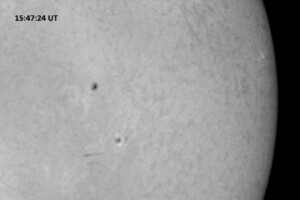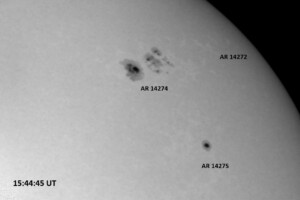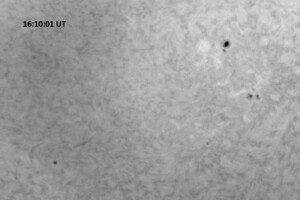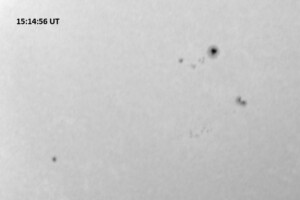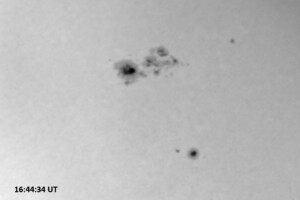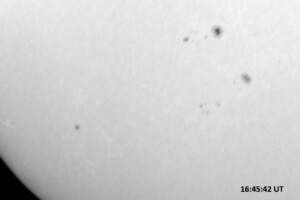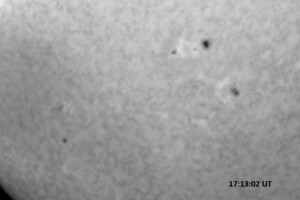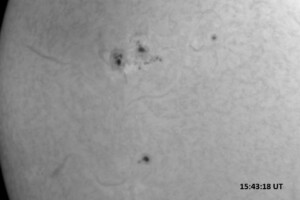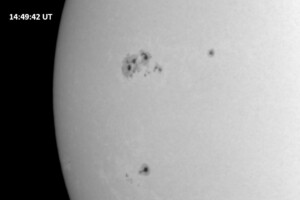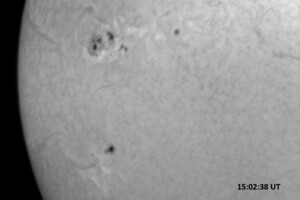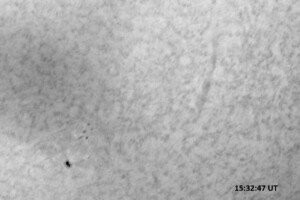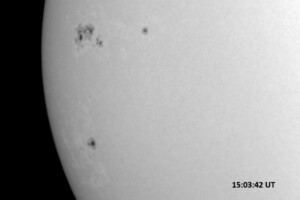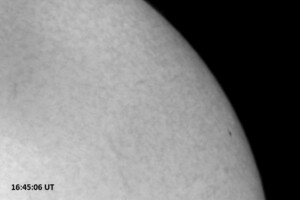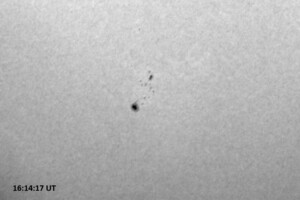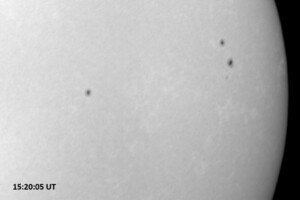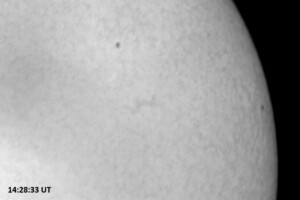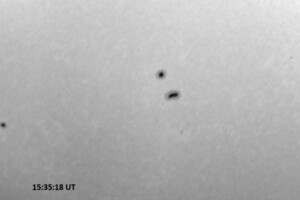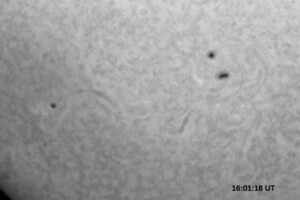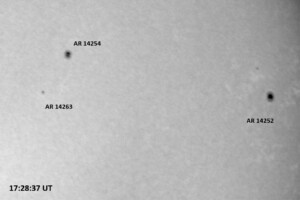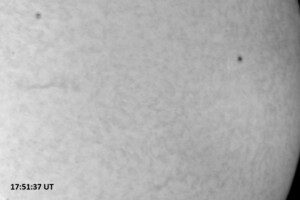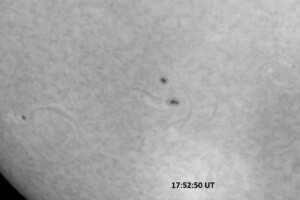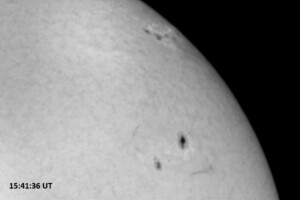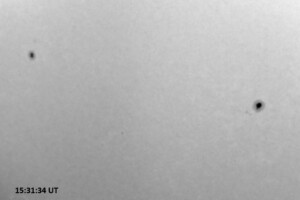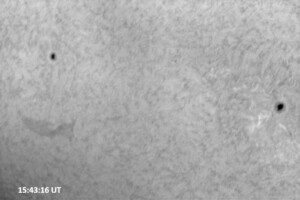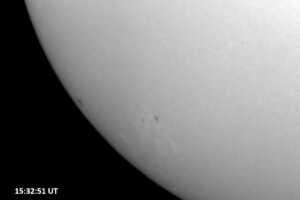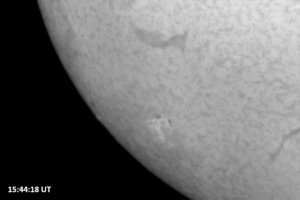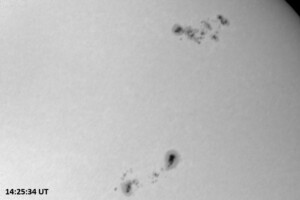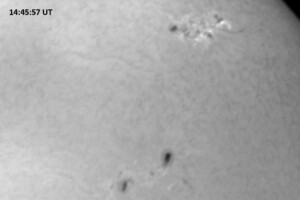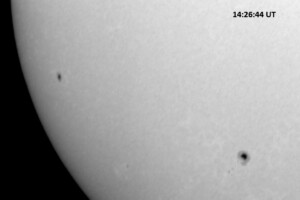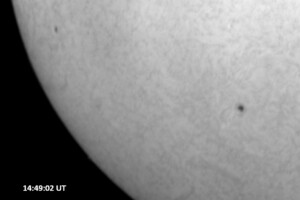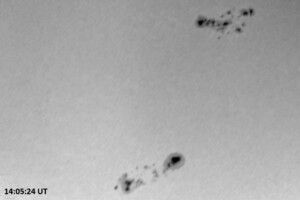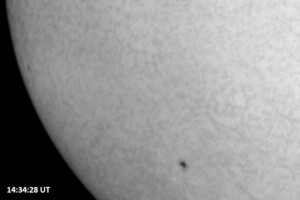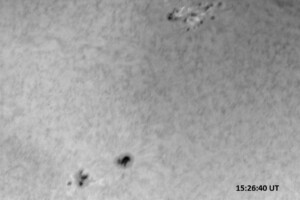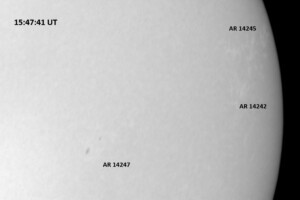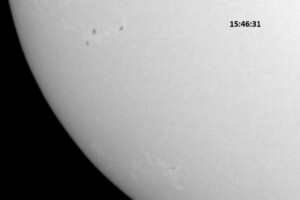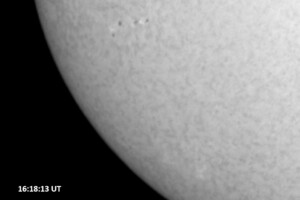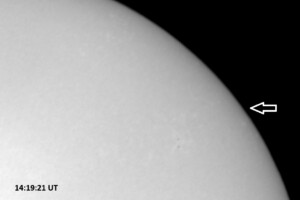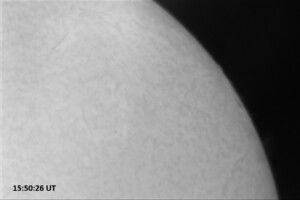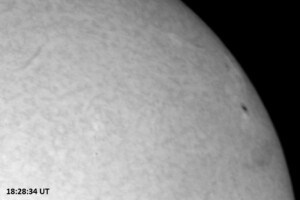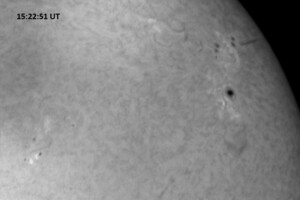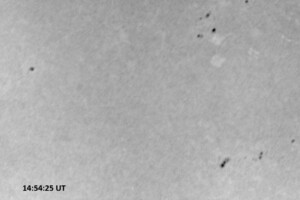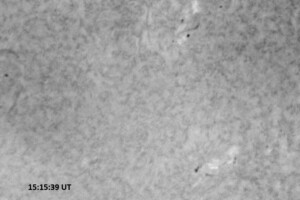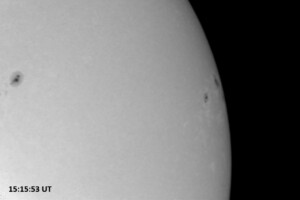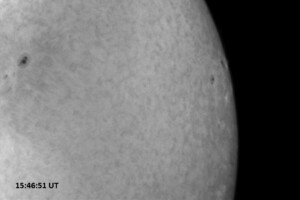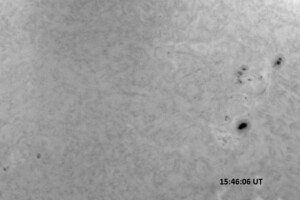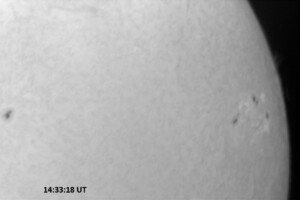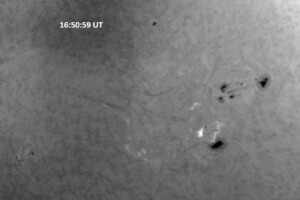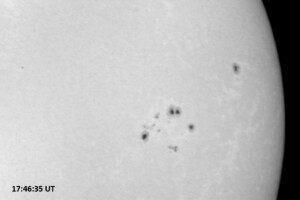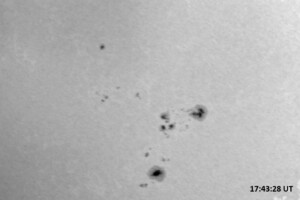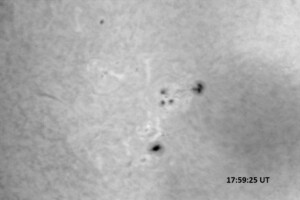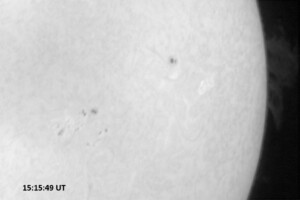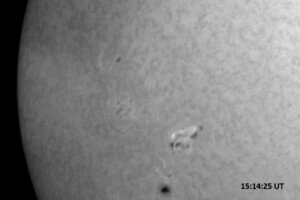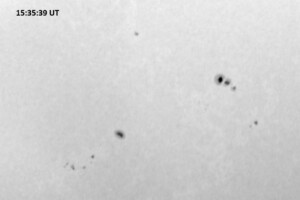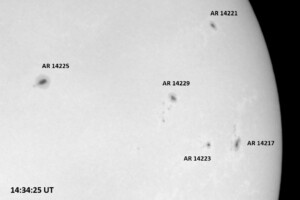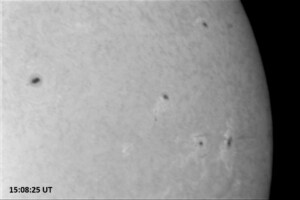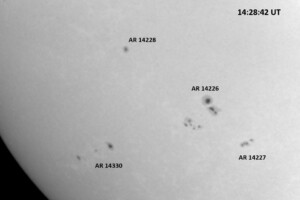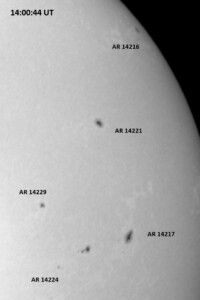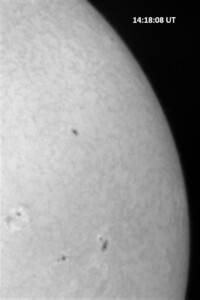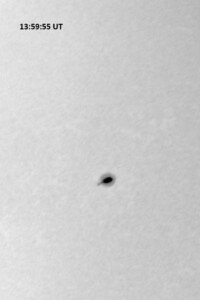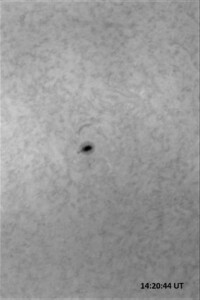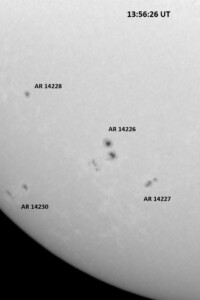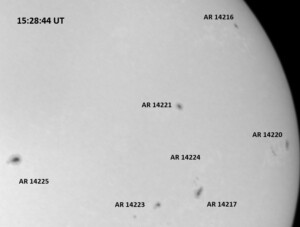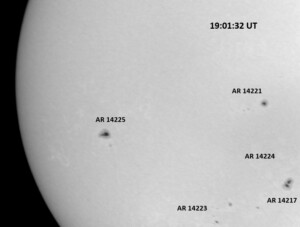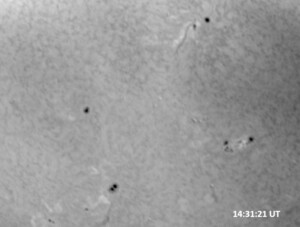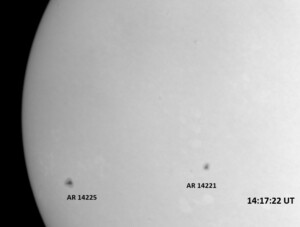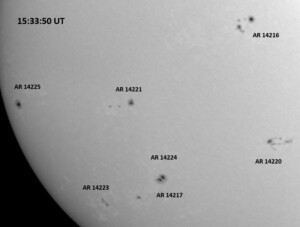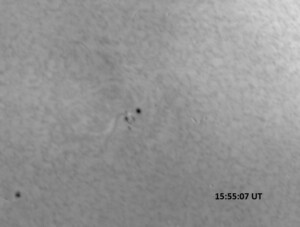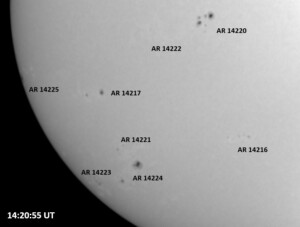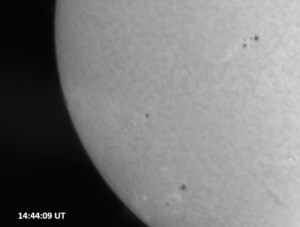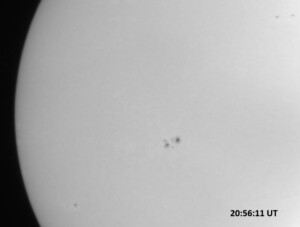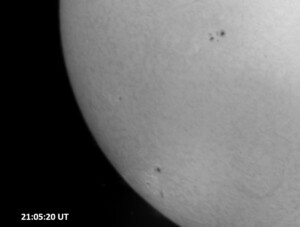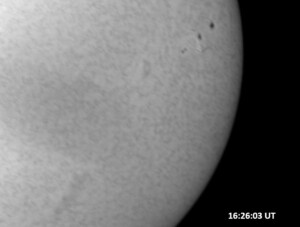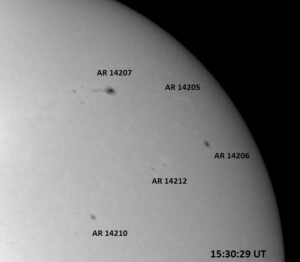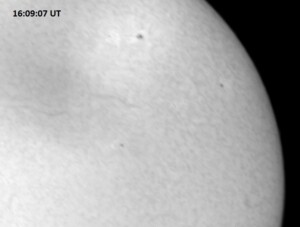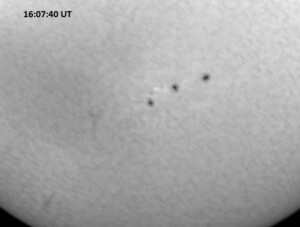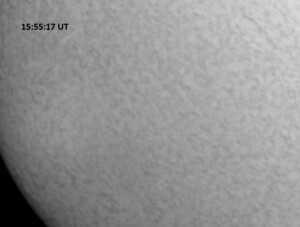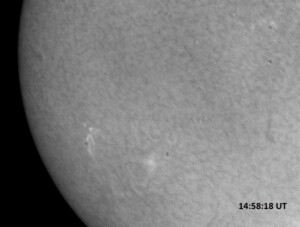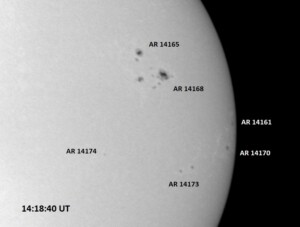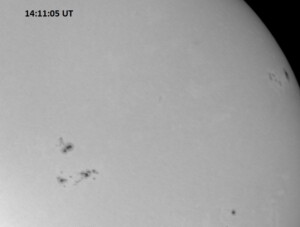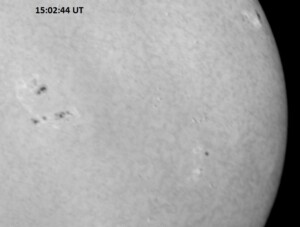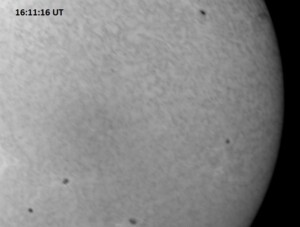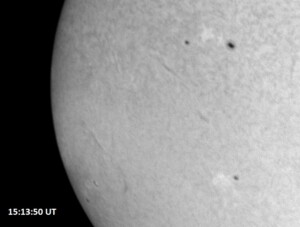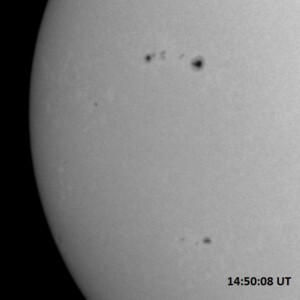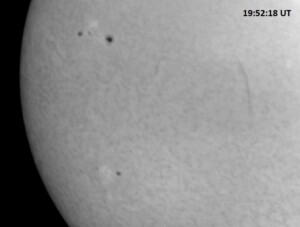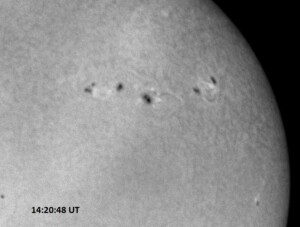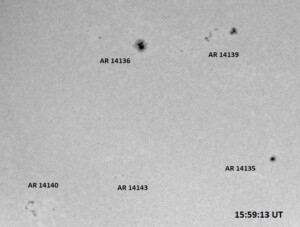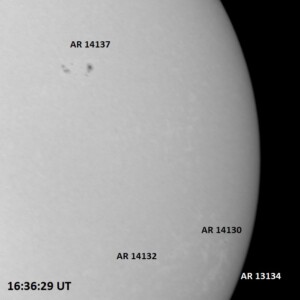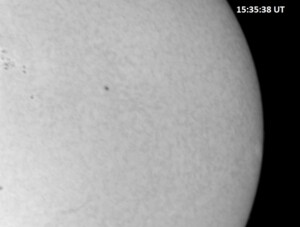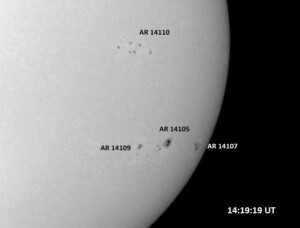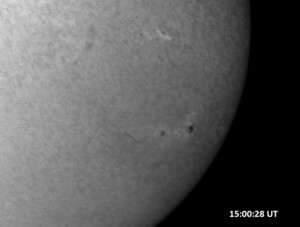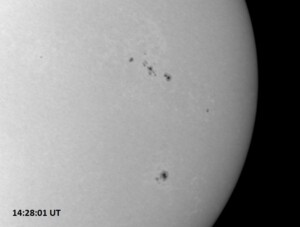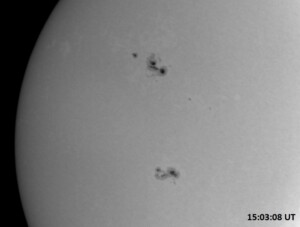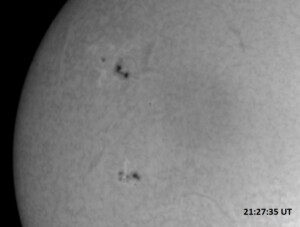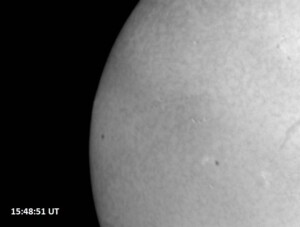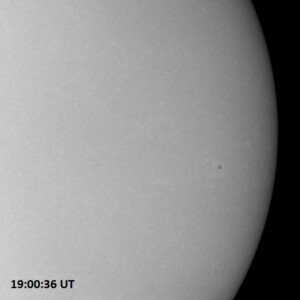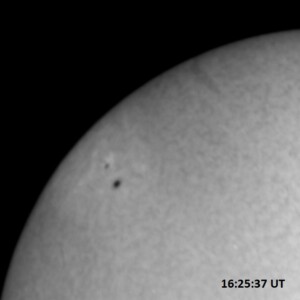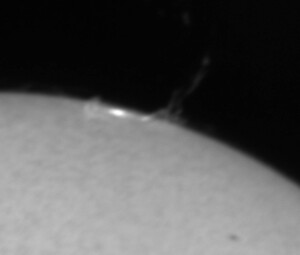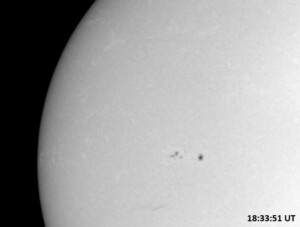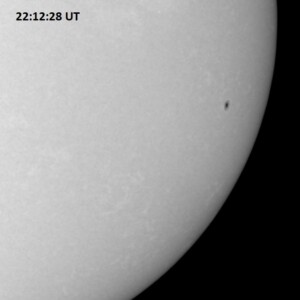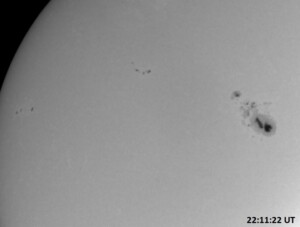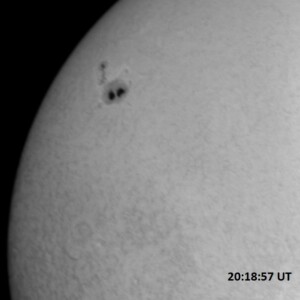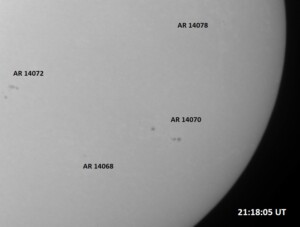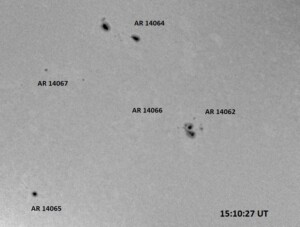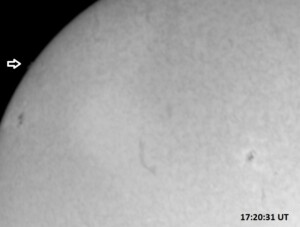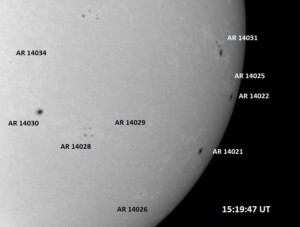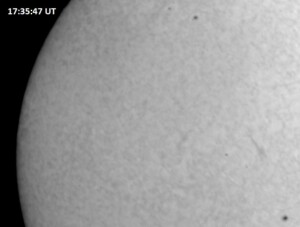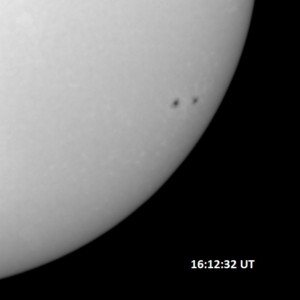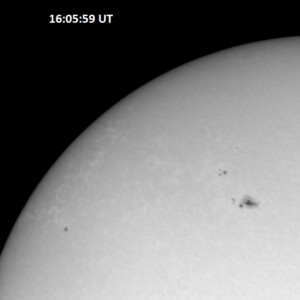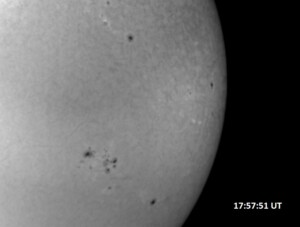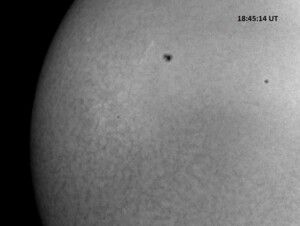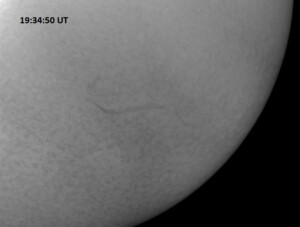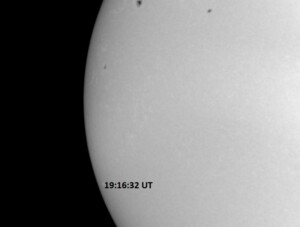The Latest Solar Images
Note: All images on this website © 2018-2025 by Brian Cudnik and Prairie View A&M Physics. All rights reserved.
Observations are happening daily, except for most Saturdays, all Sundays, and holiday periods; and are governed by duty schedule, weather, and solar activity. When the Sun has very low activity (spotless), observations will be limited or non-existent. Whenever the Sun becomes active again, the observing program will become active as well, weather permitting. The Sun is expected to reach the maximum activity level of the current Cycle 25 solar cycle. So we anticipate more events in terms of active region size and number, and solar flares.
One can monitor the Sun via several websites that provide real-time images of the Sun. The website, https://www.solarmonitor.org/, has such images in six different channels. The numbers are the NOAA designations for active regions (with the “1” at the start of the designation removed for convenience). Another website with up-t0-date information on solar activity and other goings-on in the skies is www.spaceweather.com. Additional information about the Sun’s current activity can be obtained from https://www.swpc.noaa.gov/, and real-time full-disk H-alpha images from observatories around the world can be viewed at http://halpha.nso.edu/.
A typical observing run may last from one to four hours, depending on seeing considerations, weather, and other work responsibilities, but will include active region monitoring of available active regions and the collection of frames for high-resolution solar mosaics in H-alpha. Each session includes at least one mosaic, which is a series of images made of all parts of the Sun’s disk that can later be stitched together to form a whole-disk image. At the very least, this ensures that all visible features such as prominences, filaments, and active regions (sunspot groups) are all captured in image form at least once per session. Usually observations are carried out in the late morning hours, but an additional session may occur in the mid-afternoon hours and it will include its own mosaic. If a sunspot group is expected to be active, then it becomes a main focus for observation for extended periods of time.
Solar activity is summarized in each day’s entry below, based on the forecast discussion product issued by the Space Weather Prediction Center each morning, along with observed activity (or lack of) the day of the featured observations. Regions are numbered by the NOAA/SWPC and are often provided in four-digit format (e.g. 3327), although I and other sources use the full five-digit designation (13327). Solar flares are described in terms of their X-ray intensity and optical “importance” (apparent brightness and area covered). One can learn more about the X-ray class of solar flares often discussed below by going to this website: https://www.spaceweather.com/glossary/flareclasses.html. Finally the SWPC 3-day forecast for solar activity is provided at the end of each entry.
More information about solar flares can be found at these websites: https://www.swpc.noaa.gov/phenomena; https://www.space.com/solar-flares-effects-classification-formation; and https://www.spaceweatherlive.com/en/solar-activity/solar-flares.html. I have also found the following website to be very useful: spaceweatherlive.com
The solar images are recorded through a Meade 16-inch f/8 Cassegrain telescope equipped with a 0.3 Å Hydrogen-alpha filter and a 16-bit, 3326×2504 pixel SBIG STF-8300 CCD camera. The aperture of the scope is stopped to 4-7/8 inch by an energy-rejection filter, which renders the system an f/26. A neutral density filter is added to bring the sunlight intensity down by 90%. Each image is automatically dark-subtracted as it is saved and each exposure is 0.1 second long for the red off-band continuum images and 0.5 second for the on-band H-alpha images. Flat field images are taken at periodic intervals throughout the observing session and are obtained by training the telescope to focus near the center of the Sun’s disk. Five images are then taken while dithering the frame 1′ to 5′ N,S,E, and W. The idea is to try to get images that are slightly blurred (either due to seeing or scope motion) and off set from each other. A set of 30 bias images (0-second exposures with the dome closed and scope parked) are taken at the end of each observing session.
Select images are processed for further study and display. A program called MaxIM DL is used to do basic calibration (bias-subtraction and flat field correction), and the levels are adjusted for optimum display contrast. Choice images are then selected for online display. All of the images are archived in their raw FITS format, sorted by date, and backed up twice. At a later time we can mass process these and make them available for scientific use. Inquiries can be made of Brian Cudnik, at bmcudnik@pvamu.edu, or Premkumar Saganti, at pbsaganti@pvamu.edu.]
NOTE: Images of the March 14, 2025 total lunar eclipse are posted at https://www.pvamu.edu/pvso/cosmic-corner/total-lunar-eclipse-1/
NOTE: Images of the April 8, 2024 solar eclipse are posted at https://www.pvamu.edu/pvso/cosmic-corner/partial-solar-eclipse/.
Observations have been conducted since then at the PVSO, primarily with H-alpha. There was a period of time when magnetospheric data were collected but the work had primarily been regional H-alpha images of active regions and filaments. Regular observations continued through the mid-2000’s, then became more sporadic through 2015. After a five-year pause, regular observations resumed (in their current format) on 8 January 2020.
November 13,2025
Solar activity continues to be at low levels. AR 14274 continues to produce frequent low- to mid-level C-class flares, but nothing M-class or larger since the X5.1 over two days ago. The largest was a C6.1/SF at 3:34 UT, 13 November. AR 14276 produced a C5.0/SN at 13:26 UT, 13 November, the 2nd largest of today. It then started to produce C-class flares regularly this afternoon (four since the C5) while AR 14274 seems to be quieting down. Not much change lately with AR 14274, and the rest of the spot groups (6 in all besides 14274) were either stable or in decay.
The first column below includes red continuum images, each 0.09 sec exposure; and the second column hosts H-alpha line center images, each 0.15 sec exposure. Each of the four images covers 7.8’x11.4′ on the sky. Celestial north is up, west is right in each image.
Despite the ongoing behavior of AR 14272, high solar activity is still predicted to be likely, with M-class flares expected and X-class flares likely, through 15 November.
November 12,2025
Solar activity is back to low levels today. It has been such since the end of the X5 flare event yesterday (11 November) at 12:51 UT from AR 14274. Since then, only low-level C-class flare activity has occurred for the remainder of yesterday through the end of today (to 23:55 UT). The other six regions on the solar disk were stable or decayed slightly.
The first column below includes red continuum images, each 0.09 sec exposure; and the second column hosts H-alpha line center images, each 0.15 sec exposure. Each of the four images covers 7.8’x11.4′ on the sky. Celestial north is up, west is right in each image.
Solar activity is expected to be moderate with a likely chance for X-class flares from AR 14274 through 14 November.
November 11,2025
Solar activity returned to high levels again early today. There was yet another X-class flare from AR 14274: an impulsive X5.1/3B flare which peaked at 10:04 UT today, 11 November. This region continued to grow slightly with little changed to its high magnetic complexity. AR 14274 was the source of all but one of the flare events recorded today prior to 15:00 UT. Of the total of 19 optical/X-ray events, one was the aforementioned X5 flare, a second was an M1.4/SF flare at 8:09 UT today, and the rest were low- to mid-level C-class and optical sub-flares. AR 14279 produced a C2.9/SF at 2:55 UT today, and AR 14277 was the source of a C2.7 flare today at 15:36 UT.
There are 8 spotted active regions on the visible solar disk today. Aside from AR 14274, all of them are quiet, stable, and/or in decline.
The first column below includes red continuum images, each 0.09 sec exposure; and the second column hosts H-alpha line center images, each 0.15 sec exposure. Each of the four images covers 7.8’x11.4′ on the sky. Celestial north is up, west is right in each image.
Solar activity is expected to be moderate with a chance for X-class flares through 13 November.
November 10,2025
Solar activity returned to high levels early today. There was another X-class flare from AR 14274: a long-duration X1.2/2B flare at 9:19 UT, 10 November. The event launched a full halo CME straight toward the Earth, and a proton/solar particle event is currently underway as well. AR 14274 changed little since yesterday and maintained a delta magnetic configuration. AR 14276 showed some growth, as AR 14277 lost some of its spots. These active regions were rather inactive, with only a few C-class flares each. The other spot groups were unchanged and inactive.
AR 14274 produced nearly all of the recorded flares today, mostly C-class events, and an M1.5 that we observed peaking at 19:57 UT. We observed several more C-class from this region today as well.
The first column below includes red continuum images, each 0.09 sec exposure; and the second column hosts H-alpha line center images, each 0.15 sec exposure. Each of the four images covers 7.8’x11.4′ on the sky. Celestial north is up, west is right in each image.
M-class flares are likely, with a chance for isolated X-class flares through 12 November.
November 8,2025
Solar activity was at low levels. AR 12472 continues to be the largest and most active sunspot group on the visible solar disk. It has shown signs of decay recently. The region produced multiple C-class flares, the largest of which was a C6.9 at 15:51 UT on 7 November. This was the largest of all the flares yesterday and today. AR’s 14276 and 14277 both showed growth and produced several C-class flares. AR 14274 had not produced any further M-class or higher flare activity since the M8 observed on 4 November..
The first column below includes red continuum images, each 0.09 sec exposure; and the second column hosts H-alpha line center images, each 0.15 sec exposure. Each of the four images covers 7.8’x11.4′ on the sky. Celestial north is up, west is right in each image.
Solar activity is likely to remain moderate to high, with a chance for isolated X-class flares through 10 November.
November 6,2025
Solar activity dropped back to moderate levels after yesterday’s M8.6/2B flare from AR 14274 at 22:07 UT. No similarly or more powerful event has happened since (and this continues through 7 November, with only two low-level M-class flares and many C-class flares). The M8 flare launched a CME off the NNE limb of the Sun. AR 14274 continues to grow, but displays an unusual property that the spots’ magnetic polarities are lined up north to south. They are usually east-west. In spite of the NOAA/SWPC assertion of further large flares, the largest that has happened was an M1.7 at 7:15 UT on 7 November.
AR 14276 rotated into better view and was responsible for the X1.1 flare at 22:01 UT on 4 November. This region was the source of an M1.1 flare at 4:31 UT on 6 November. Active regions 14272, 14273, 14274, 14275, and 14276 each contributed at least one C-class flare on 6 November.
The first column below includes red continuum images, each 0.09 sec exposure; and the second column hosts H-alpha line center images, each 0.15 sec exposure. Each of the four images covers 7.8’x11.4′ on the sky. Celestial north is up, west is right in each image.
Solar activity is expected to remain at moderate to high levels as the active regions on the eastern half of the solar disk, especially AR 14274 continue to be active. There is an up to 80% chance for an M-class flare, and up to 35% chance for an X-class flare through 8 November.
November 5,2025
Solar activity was high due to a pair of X-class flares yesterday. AR 14274 produced an X1.8/1B flare at 17:34 UT yesterday, 4 November. This produced radio sweep signals, 10-cm radiation (160 solar flux units strong) and a partial halo CME mostly off the NE limb of the Sun. This CME may graze the Earth’s magnetic field in 1-2 days. AR 14274 continues to grow in size and complexity but the group as a whole began to spread out (east-west). An active region just beyond the ESE limb produced the second X-flare: an X1.1 that peaked at 22:01 UT on 4 November. This also launched a CME, but this will miss Earth entirely. AR 14272 produced an M1.7/1F flare at 22:44UT, 4 November. A non-Earth directed CME launched off the NE limb, starting at 23:!2 UT on 4 November.
Early today, at 11:19 UT, AR 14274 produced a long-duration M7.4/2N flare. The region produced two more near-M class flares early today: a C8.0 at 3:01 UT, a C9.9/SF at 5:05 UT; AR 14275 produced a C8.3/1F at 14:30 UT, just before the start of our observing session. Since observations started at 14:50 UT all of this activity quieted down, and solar activity slipped back to low ranges. We monitored the AR 14272/14274/14275 all day today (expecting to be able to continue through 22:45 UT, when the Sun will get too low to observe). Then, at 22:07 UT, an M8.6 flare came from the north side of AR 14274, returning solar activity levels to high. We captured most of the event, before the Sun got too low. We plan to repeat the all-day monitoring again Thursday, 6 November.
The first column below includes red continuum images, each 0.09 sec exposure; and the second column hosts H-alpha line center images, each 0.15 sec exposure. Each of the four images covers 7.8’x11.4′ on the sky. Celestial north is up, west is right in each image.
Solar activity is likely to remain moderate to high, with a 70% probability for M-class flares and a 25% probability for X-class flares through 7 November. The primary source of these flares continues to be AR 14274.
November 4,2025
Solar activity returned to high levels today with an X1.8/1B flare from AR 14274 (after we had closed for observations for today…), peaking at 17:34 UT. This region produced all but two of the reported flares so far today (the two were low-level C-class flares, one from AR 14275 and the other from AR 14273). AR 14274 is experiencing moderate growth and a large delta magnetic configuration. AR 14273 grew slightly, as did AR 14275. AR 14267 rotated over the western limb today. A coronal mass ejection is in the process of erupting off the northeast part of the Sun. It is visible in the SOHO C3 (wide field coronagraph) image from 20:06 UT. It has yet to be determined if this CME has an Earth directed component, but based on the location of origin on the solar disk, it is not likely.
The first column below includes red continuum images, each 0.09 sec exposure; and the second column hosts H-alpha line center images, each 0.15 sec exposure. Each of the four images covers 7.8’x11.4′ on the sky. Celestial north is up, west is right in each image.
There is a 60% probability for M-class flares and a 10% probability for X-class flares through 6 November.
November 3,2025
Solar activity became high after some M-class events from AR 14274. The first was an M1.6 that peaked today, 3 November, at 9:25 UT. The second was a long-duration M5.0 that peaked at 10:11 UT. This was soon followed by an M2.9 at 12:35 UT. Finally, an M1.5/SF peaked at 17:08 UT, and this was observed from PVSO. Since then, through 21:40 UT, only low level C-class events have happened. AR 14274 is the likely return of old AR 14246, which was active on its previous passage across the solar disk as well as its transit on the far side of the Sun over the past two weeks. AR 14267 produced a long-duration C8.2 flare at 12:46 UT on 2 November. The region has been quiet al day today. AR 14272 was the source of a few C-class flares, one of which was observed prior to the M1.5 flare at PVSO. AR 14273 rapidly emerged over the weekend but was mostly quiet, with no recorded flare activity so far today.
The first column below includes red continuum images, each 0.09 sec exposure; and the second column hosts H-alpha line center images, each 0.15 sec exposure. Each of the four images covers 7.8’x11.4′ on the sky. Celestial north is up, west is right in each image.
Solar activity is expected to be at mainly low levels, with an increasing chance for M-class flares through 4 November. On 5 November, M-class flares become likely, with a slight chance for an isolated X-class flares.
October 31,2025
Solar activity rose to low levels again today with a series of long duration low-level C-class events from regions over the eastern limb. Yesterday’s C1.4 flare (30 Oct., 12:37 UT) followed a small filament eruption near the Sun’s west limb. At least four more low-level C-class events have occurred so far today, the largest of which was a long duration C7.1 at 20:42 UT today. The GONG imagery show no obvious source for this or the earlier C3. 7 event that happened earlier today at 16:52. Only three spots are easily visible (AR 14267 is the largest, then 14269 and 14261, each barely visible), as two others decayed. The Sun is nearly blank, but that could chance in 1-3 days as active regions on the far side of the Sun begin to rotate into view.
An approximately 12 degree long filament erupted in the northeast quadrant of the Sun at 6:45 UT on 30 October and produced a CME, which blended (from Earth’s perspective) with another CME beyond the NE limb of the Sun.
The first image below is a red continuum images, 0.09 sec exposure; and the second image is an H-alpha line center image, 0.15 sec exposure. Each of the two images covers 7.8’x11.4′ on the sky. Celestial north is up, west is right in each image.
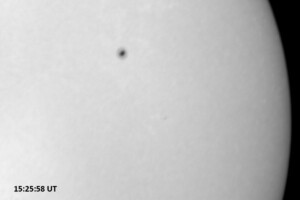 |
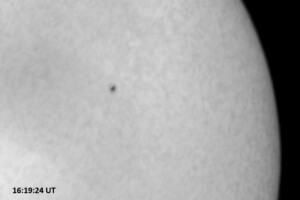 |
Solar activity is expected to remain very low with a chance for C-class flares through 1 November. By 2 November, some more active spot groups are expected to return, raising the probability of C-class flares to likely and adding a slight chance of M-class flares.
October 30,2025
Solar activity has been very low, but a long-duration C1.4 peaking at 12:36 UT raised it back to the low range. For the last three days, the X-ray background has been in the low- to mid-B range and since today’s lone flare, has “flatlined” again and continues to be such. One of the far-side regions about to rotate back into view was likely responsible for this event. Slight decay occurred in AR’s 14266, 14267, and 14269. AR 14271 rotated into view and is only a small, single spot.
The first image below is a red continuum images, 0.09 sec exposure; and the second image is an H-alpha line center image, 0.15 sec exposure. Each of the two images covers 7.8’x11.4′ on the sky. Celestial north is up, west is right in each image.
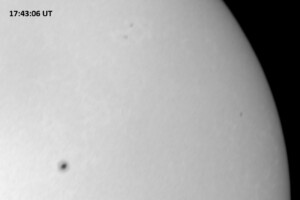 |
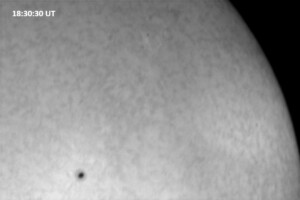 |
Solar activity is expected to remain very low with a chance for C-class flares through 31 October. By 1 November, some more active spot groups are expected to return, raising the probability of C-class flares to likely and adding a slight chance of M-class flares.
October 28,2025
Solar activity persists at very low levels, with a single C1.7 flare today bringing it back up to “low” levels. This flare came from AR 14267 (while we were in the midst of the white light imaging session prior to H-alpha imaging) and peaked at 16:26 UT. The last C-class flare was yesterday at 10:15 UT, a C1.7. All of the 9 visible single spots and spot groups have simple magnetic configurations.
What the active regions lack in interesting phenomena was made up for by an active filament. A large filament erupted around 23:30 UT yesterday, 27 October, then disappeared completely by 6:17 UT today (28 October. This was in the east-northeastern part of the solar disk.
The first column below includes red continuum images, each 0.09 sec exposure; and the second column hosts H-alpha line center images, each 0.15 sec exposure. Each of the four images covers 7.8’x11.4′ on the sky. Celestial north is up, west is right in each image.
Solar activity is expected to remain very low through 30 October.
October 27,2025
Solar activity remains at low levels. ARs 14256, 14262, and 14266 have produced low-level C-class activity over the last two days, the strongest of these was a C1.7 at 10:21 from AR 14262. All eight visible spotted active regions were quiet, small, and stable, and there are also six spotless numbered plage regions visible on the solar disk. The largest spotted active region was AR 14267, with an area of 140 MSH.
The first column below includes red continuum images, each 0.09 sec exposure; and the second column hosts H-alpha line center images, each 0.25 sec exposure. Each of the four images covers 7.8’x11.4′ on the sky. Celestial north is up, west is right in each image.
Solar activity is expected to remain low through 29 October.
October 23,2025
Solar activity remains at low levels. Currently there are ten active regions (taking the form of single spots and small spot groups) on the visible disk, with three are barely there as they decay. All of these have simple magnetic complexities and are mostly stable or in decay. A new AR has rotated onto the solar disk, AR 14267, and has been the source of most of yesterday’s low-level C-class flare activity. There were six C-class flare events today between 1:59 UT and 14:50 UT today, but only one has been (so far) attributed to AR 14267. Since 16:00 UT and continuing through the time of this writing (23:10 UT), solar activity dropped to very low levels.
A few filaments have erupted yesterday and today, but none resulted in coronal mass ejections. This is likely due to the material being reabsorbed into the corona or the Sun itself or source locations being on the far side of the Sun. There were several unrelated CME’s but none of them was Earth directed. One event of interest was a fast far side CME highlighted on today’s (October 23, 2025) spaceweather.com page (image animation below, click on to set in motion). It is headed directly to Venus.
The first column below includes red continuum images, each 0.15 sec exposure; and the second column hosts H-alpha line center images, each 0.30 sec exposure. Each of the four images covers 7.8’x11.4′ on the sky. Celestial north is up, west is right in each image.
Solar activity is expected to remain low, with a slight chance for isolated M-class flares through 25 October.
October 22,2025
Solar activity continues to be low. A C3.7 flare happened at 6:49 UTC on 21 October, coming from an active region beyond the northeastern solar limb. This was the largest flare that occurred yesterday. Early today, AR 14257 produced a C4.4/SF at 0:34 UT, and at 1:52 UT, AR 14259 produced a C4.7 flare flare. The latter was the largest of today (so far, through 23:15 UT). ARs 14252 and 14263 grew slightly, and the remaining active regions were stable and unremarkable. A filament disappeared north of disk center at 9:00 UT on 21 October. Between 6:00 and 14:00 UT today, four additional C-class flares occurred, but no information on these are available as of this writing.
The first column includes red continuum images, each 0.09 sec exposure; and the second column hosts H-alpha line center images, each 0.15 sec exposure. Each of the four images covers 7.8’x11.4′ on the sky. Celestial north is up, west is right in each image.
Solar activity is expected to remain low, with a slight chance for isolated M-class flares through 24 October.
October 21,2025
Solar activity is low. With the source of all the activity of last week rotating out of view several days ago, activity levels have returned to low levels. The overall X-ray flux has declined over the last three days, with the most recent M1.0 flare being 5:25 UT on 20 October. There were only two low-level C-class flares today, one from AR 14248, which just rotated out of view. There are currently ten small spots and spot groups, all of which are quiet and stable.
The first column includes red continuum images, each 0.09 sec exposure; and the second column hosts H-alpha line center images, each 0.15 sec exposure. Each of the four images covers 7.8’x11.4′ on the sky. Celestial north is up, west is right in each image.
Solar activity is expected to remain low, with a chance for isolated M-class flares through 23 October.
October 17,2025
Solar activity continues to be at moderate levels due to ongoing M-class flare activity from AR 14246. This region continued to produce many C-class and M-class flares yesterday and today. So far today (through 20:55 UT) the region has produced 7 to 8 M1 flares (the number depends on whether a broad peaked M1 flare with two muted peaks 5 minutes apart gets counted as one or two events). AR 14248 has been very quiet in comparison, having contributed only one C8 flare early today. This region is little changed. AR 14255 rotated into view and is emerging/growing/evolving. A filament near AR 14250 launched itself off the Sun around 5:20 UTC today, but nothing has been seen in coronagraph imagery.
The first column includes red continuum images, each 0.09 sec exposure; and the second column hosts H-alpha line center images, each 0.15 sec exposure. Each of the four images covers 7.8’x11.4′ on the sky. Celestial north is up, west is right in each image.
Solar activity is likely to remain moderate, with a good chance for M-class flares and a slight chance for X-class flares through 18 October. These chances go down with AR 14246 rotating over the WNW limb.
October 15,2025
Solar activity continues to be at moderate levels due to ongoing M-class flare activity. AR 14246 is the source of most of the flares the last two days. The largest of these was a long-duration M4.8/2N flare peaking at 4:15 UT on 15 October. This blew out a CME that is expected to pass north of the Earth. AR 14248 produced an M2.0/1N flare at 12:47 UT on 14 October. As of 19:00 UT today (15 Oct.) AR 14246 has produced 9 C-class and 3 M-class flares, with no other region having been recorded as adding to the events. In addition to the M4.8 flare, AR 14246 produced an M3.7 at 7:18 UT today, and an M1.1 at 14:10 UT today. Since the M1.1 event, the X-ray background flux very slowly declined, finally dropping below C5.0 at 17:28 UT, almost 3.5 hours after the peak of the M1.1 event. AR 14246 also produced a near-M event: a C9.1 at 3:45 UT. Additional C-class events were embedded in the slowly declining X-ray flux. No further M-class flares have occurred until 22:00 UT when a slow-rising M2.7 flare occurred, peaking (so far) at 22:28 UTC.
ARs 14246 and 14248 both continue to grow in size and magnetic complexity. AR’s 14250 and 14252 were stable while 14251 showed some decay. Spotless region 14247 produced a C3.6 flare yesterday (14 October) at 14:55 UT, and other active regions just over the East and West limbs of the sun contributed C-class flare activity mainly yesterday. Currently there are six spotted active regions on the solar disk, and more may rotate into view in the coming days.
The first column includes red continuum images, each 0.09 sec exposure; and the second column hosts H-alpha line center images, each 0.15 sec exposure. Each of the four images covers 7.8’x11.4′ on the sky. Celestial north is up, west is right in each image.
Solar activity is likely to remain moderate, with a good chance for M-class flares and a slight chance for X-class flares through 17 October.
October 14,2025
Solar activity remains at moderate levels due to ongoing M-class flare activity. AR 14246 underwent some significant evolution, gaining size and new spots, and was the primary source of activity, including an M1.2 flare at 13:18 UTC on 13 October, an M2.0 at 12:47 UT today (14 October) and an M3.1 at 20:36 UT today. It also produced numerous C-class flares (16 so far today and counting, four of which occurred during our observing session) and optical flares. All of this activity has launched several CMEs into space, with potential Earth-directed components. A prominence erupted off the ENE limb of the Sun, first observed by satellite after 0:36 UT, 14 October. The debris is not Earth-directed.
There are seven spotted active regions on the visible disk of the Sun today, most of which were unremarkable. AR 14248 grew in length, while AR 14247 and 14250 decayed. The new active regions that recently rotated into view (AR 14252 and AR 14254) were both quiet.
The first column includes red continuum images, each 0.09 sec exposure; and the second column hosts H-alpha line center images, each 0.15 sec exposure. Each of the four images covers 7.8’x11.4′ on the sky. Celestial north is up, west is right in each image.
Solar activity is likely to remain moderate, with a good chance for M-class flares and a slight chance for X-class flares through 16 October.
October 13,2025
Solar activity is at moderate levels with multiple M-class flares from AR 14246: an M1.9/1N flare peaking at 5:26 UT today (13 Oct.), an M2.7 flare at 9:19 UT, and an M1.2 at 13:19 UT. There were two C9 events from this region as well. The M1.9 produced a faint CME, which may be headed for Earth, more details and modeling are needed to know for sure. AR’s 14246 and 14248 produced many C-class flares yesterday and today. AR 14246 produced four C-class flares during our three-hour observing session this morning, the largest of which was a C7.2 at 16:53 UT. The region also produced an impressive looking C8.0 flare at 19:06 UT today.
The remaining five active regions on the visible disk are either stable or in slow decline.
The first column includes red continuum images, each 0.09 sec exposure; and the second column hosts H-alpha line center images, each 0.15 sec exposure. Each of the four images covers 7.8’x11.4′ on the sky. Celestial north is up, west is right in each image.
Solar activity is likely to remain low, with a chance for M-class flares through 15 October.
October 10,2025
Solar activity was low. The only event today (so far, through 19:30 UT) was a C2.3 flare at 6:29 UT from AR 14241. Then at 20:16, AR 14246 produced a C1.7 flare. It appears little more than two tiny spots next to each other and was considered spotless yesterday. There are seven tiny spot groups on the visible disk of the Sun today, the largest of which is AR 14248 at approximately 150 millionths of solar hemisphere (MSH) surface area.
The first column includes red continuum images, each 0.09 sec exposure; and the second column hosts H-alpha line center images, each 0.15 sec exposure. Each of the four images covers 7.8’x11.4′ on the sky. Celestial north is up, west is right in each image.
Solar activity is likely to remain low, with a slight to low chance for M-class flares through 12 October. The chances may increase over the next several days as larger, more active regions rotate back into view.
October 9,2025
Solar activity returned to moderate levels with a long-duration M2.0 flare at 12:31 UT today from over the Sun’s western limb. This was likely from AR 14236 as “debris” was visible above the area on images taken two hours after the event. AR 14232 produced low-level C-class flares as it rotated over the western limb. AR 14242 produced a C1.2 flare at 12:48 UT on 8 October. AR 14241 produced a C1.7 flare at 5:17 UT today (9 October) and decayed some in its leading spots. AR 14247 has grown a bot. A CME launched off the NE limb starting at around 6:30 UT on 9 October. This was associated with an active filament in the northeast quadrant of the Sun. Other filaments remained intact as of this writing.
The first column includes red continuum images, each 0.09 sec exposure; and the second column hosts H-alpha line center images, each 0.15 sec exposure. Each of the four images covers 7.8’x11.4′ on the sky. Celestial north is up, west is right in each image.
Solar activity is likely to remain low, with a slight to low chance for M-class flares through 11 October.
October 8,2025
Solar activity continues at low levels. AR 14236 produced a C5.6 flare at 11:29 UT yesterday, 7 October. Yesterday’s (7 October) C9.1 flare (peaking at 20:07 UT) from spotless region 14233 came from the eruption of an approximately 4 degree long filament close to the region. Only three low-level C-class flares have happened so far today: a C1.9 at 4:37 UT from AR 14232, a C1.0 at 5:15 UT from AR 14242, and a C1.2 at 12:48 UT, also from AR 14242.
The first column includes red continuum images, each 0.09 sec exposure; and the second column hosts H-alpha line center images, each 0.15 sec exposure. Each of the four images covers 7.8’x11.4′ on the sky. Celestial north is up, west is right in each image.
Solar activity is likely to remain low, with a slight chance for M-class flares through 10 October.
October 7,2025
Solar activity is at low levels. AR 14232 produced most of the activity these last two days, including a few low-level C-class flares. AR 14236 maintains itself in terms of size and magnetic complexity but only produced a C5.3 flare today at 11:29 UT. Spotless region 14233 produced an almost M-flare today: a C9.1 flare, the largest in more than four days. AR 14241 grew another spot. AR 14242 also grew some while another active region, 14245 emerged just ahead of it. The filament eruption of late 5 October did not produce a CME. Yesterday’s C5.1 flare from spotless region 14233 was caused by another filament eruption. This debris is projected to cross well ahead of Earth. Another filament erupted near AR 14244.
The first column includes red continuum images, each 0.09 sec exposure; and the second column hosts H-alpha line center images, each 0.15 sec exposure. Each of the four images covers 7.8’x11.4′ on the sky. Celestial north is up, west is right in each image.
Solar activity is likely to be low, with a chance for M-class flares and a slight chance for an X-class flare, through 9 October.
October 6,2025
Solar activity is at low levels. The last M-class flare happened on 3 October at 14:40 UT, and there has not been any further M-class activity through 21:10 UT today. Low-level C-class flares came from a source over the west limb and that has been the strongest of activity yesterday through today. AR 14241 produced a C1.9 flare at 8:49 UT on 6 October. AR 14232 produced a C1.7 flare at 12:41 UT, 6 October. AR 14232 and 14236 were the largest sunspot groups on the visible disk (areas of 260 MSH and 190 MSH, respectively), but neither produced any notable activity (except for the C1) yesterday or today (so far). And then, at 20:36UT, spotless region 14233 produces a C5.1 flare, the largest in three days. There are currently seven (7) spotted regions on the visible solar disk.
A filament in the southeast quadrant of the solar disk erupted, beginning around 20:00 UTC on 5 October and continued through the early part of today.
The first column includes red continuum images, each 0.09 sec exposure; and the second column hosts H-alpha line center images, each 0.15 sec exposure. Each of the four images covers 7.8’x11.4′ on the sky. Celestial north is up, west is right in each image.
Solar activity is likely to be low, with a chance for M-class flares and a slight chance for an X-class flare, through 8 October.
October 3,2025
Solar activity is at moderate levels because of an M1.5/2N flare that peaked at 5:23 UT early today from AR 14236. This flare was associated with a filament disruption event, where part of the filament was launched into space, creating a faint CME that was first observed today at 5:48 UT. It is not yet determined where this is headed. There are 10 spotted active regions currently visible on the solar disk. Another CME erupted from just behind the west limb of the Sun around 11:00 UTC today.
AR 14232 produced a double-peaked C9.7 flare that occurred at 6:11 UT. A long duration M1.2 flare peaked at 14:36 UT today but does not (yet) have an associated active region listed. It may have come from behind the east or west limb of the Sun. The same may be true for a C6.1 at 12:37 UT, a C7.9 at 15:35 UT, and a C7.3 at 17:16 UT today. None of these had optical signals as they occurred during the observation session; again, they may have originated beyond the solar horizon. Aside from a C2.5 “bump” at 20:06 UT today, all has been quiet since the C7.3 event (through 21:10 UT). At 2110 UT, AR 14242 started to flare. It was a rather compact and bright looking C3.0 that peaked at 21:14 UT.
The first column includes red continuum images, each 0.09 sec exposure; and the second column hosts H-alpha line center images, each 0.15 sec exposure. Each of the four images covers 7.8’x11.4′ on the sky. Celestial north is up, west is right in each image.
Solar activity is likely to be low to moderate, with a slight chance (10%) for an X-class flare, through 4 October, and a decreasing chance of M-class flares through 5 October.
October 2,2025
Solar activity stayed at moderate levels with an M1.2 flare from AR 14226 at 2:09 UT on 2 October. This flare launched a CME (coronal mass ejection), which is expected to cross Earth’s orbit well ahead of the Earth. AR 14232 grew in size and magnetic complexity. ARs 14232 and 14236 are situated at the center of the solar disk and produced only a few low-level C-class flares. ARs 14233, 14235, and 14236 produced several C-class and optical subflares today. Since the M1.2 flare, solar activity returned to low levels, where it continues through 22:30 UTC today.
The first column includes red continuum images, each 0.09 sec exposure; and the second column hosts H-alpha line center images, each 0.15 sec exposure. Each of the four images covers 7.8’x11.4′ on the sky. Celestial north is up, west is right in each image.
Solar activity is likely to be low to moderate, with a slight chance (10%) for an X-class flare, through 4 October.
October 1,2025
Solar activity remains at moderate levels today due to M-class flare activity coming from AR 14232. It produced an M1.2/1N flare that peaked at 2:26 UT today. This was followed by another M1.2/1N flare from the same region at 16:50 UT, which was observed at PVSO. There were three larger C-class flares as well, the largest being a C8.6 at 11:35 UT from AR 14236. AR 14232 maintains a stable size and stable magnetic complexity. The most magnetically complex active regions are AR 14230 and AR 14236. Both showed a higher frequency of C-flare production yesterday, but that frequency has dropped off today apparently. We focused on AR 13230 because forecasts and its MacIntosh spot classification indicated that it had the highest probability of producing an M-class flare today. However, it remained quiet throughout the two hour monitoring and has (so far, as of 19:01 UT) only produced the above mentioned C8 flare.
There are currently nine spotted active regions visible on the solar disk today. Three of these regions (AR 14230, 14232, and 14236) are responsible for the continued likelihood of moderate solar activity in the coming three days.
The first column includes red continuum images, each 0.09 sec exposure; and the second column hosts H-alpha line center images, each 0.15 sec exposure. Each of the four images covers 7.8’x11.4′ on the sky. Celestial north is up, west is right in each image.
Solar activity is likely to be moderate, with a slight chance for X-class flare, through 3 October.
September 30,2025
Ongoing M-class flare activity maintains the moderate level of solar activity. AR 14232 produced an M1.2 flare at 0:56 UT on 30 September as it grew in spot number, area, and magnetic complexity. AR 14226 produced an M2.7/1N at 9:40 UTC on 30 September and remained stable in size and magnetic complexity. AR 14230 doubled in overall area and became more magnetically complex; and AR 14236 grew as well in spot number and magnetic complexity. AR 14228 produced an M1.8/SF at 12:27 UT today. This was the last M-class flare to happen for the rest of the day, with the Sun being quiet after 12:30 UT. After this time the largest event was a C4.0 from AR 14226 at 21:42 UT. Altogether, eight spotted active regions are visible on the solar disk.
The first column includes red continuum images, each 0.09 sec exposure; and the second column hosts H-alpha line center images, each 0.15 sec exposure. Each of the four images covers 7.8’x11.4′ on the sky. Celestial north is up, west is right in each image.
Solar activity is likely to be moderate, with a slight chance for X-class flare, through 2 October.
September 29,2025
Solar activity increased to moderate levels, and continues to be so going into today. AR 14232 produced an M6.3 flare at 8:42 UT on 28 September, then an impulsive M3.6 flare today at 1:45 UT. These events launched CMEs. AR 14236 produced an M1.0/SF flare at 11:08 UTC today. There were four M-class flares from three different regions so far today (AR’s 14232, 14233, and 14236), with the most recent (as of 21:00 UT) being an M1.0 at 11:59 UT. Since then, only frequent C-class flares have occurred from ARs 14227, 14230, 14232, and 14236. There are ten visible spotted active regions on the Sun today, the largest of which is AR 14232, with an area of 180 MSH.
The first column includes red continuum images, each 0.09 sec exposure; and the second column hosts H-alpha line center images, each 0.15 sec exposure. Each of the four images covers 7.8’x11.4′ on the sky. Celestial north is up, west is right in each image.
Solar activity is likely to be moderate, with a slight chance for X-class flare, through 1 October.
September 26,2025
Solar activity continues to be at low levels. So far today, only low level C-class activity has occurred, two of which came from new AR 14232 which just rotated into view on the eastern limb. The others came from AR 14217 and 14227. At 20:01 UT today, solar activity increased to moderate with an M1.6 flare from an unspecified region. AR 14221 also produced a C7.8 at 19:05 UT. Aside from these, all the regions on the Sun were mainly stable or in decay.
The first column includes red continuum images, each 0.09 sec exposure; and the second column hosts H-alpha line center images, each 0.20 sec exposure. Each of the four images covers 7.8’x11.4′ on the sky. Celestial north is up, west is right in each image.
Solar activity is expected to be low, with a chance for an isolated M-class flare, through 28 September.
September 25,2025
Solar activity has returned to low levels today after reaching moderate levels yesterday. AR 14224 produced an M1.6 flare yesterday (24 September) at 19:13 UT. The region remains simple, although it has grown slightly. AR 14229 and 14217 flank AR 14224 to its north and south, respectively; and another region, 14231, emerged east of all these. These regions (except for 14231) were the sources of multiple C-class flares, both yesterday and today. AR 14217 only produced low-level C-class flares today (so far, through 22:21 UT). AR 14226 also produced C-class flares yesterday, and a single C2.4/SF today at 19:21 UT. The remaining spot groups were quiet.
The first column includes red continuum images, each 0.09 sec exposure; and the second column hosts H-alpha line center images, each 0.20 sec exposure. Each of the four images covers 7.8’x11.4′ on the sky. Celestial north is up, west is right in each image.
Solar activity is expected to be low, with a chance for an isolated M-class flare, through 27 September.
September 24,2025
Solar activity remains at moderate levels. AR 14217 produced an M1.0 flare at 9:31 UT today. Then AR 14224 produced an M1.6 flare at 19:13 UT this afternoon. Rather frequent C-class flaring occurred from AR’s 14223, 14224, and 14226. In fact, AR 14226 grew some more since yesterday. It and AR 14217 have similar spot areas, at 170 MSH each. The third largest region is AR 14220, at 150 MSH. All of the other visible active regions are much smaller, stable, or in slow decay.
The first column includes red continuum images, each 0.09 sec exposure; and the second column hosts H-alpha line center images, each 0.20 sec exposure. Each of the four images covers 7.8’x11.4′ on the sky. Celestial north is up, west is right in each image.
Solar activity is expected to be low, with a chance for an isolated M-class flare, through 26 September.
September 23,2025
Solar activity reached moderate levels as a result of an impulsive M1.0/SF event today at 10:34 UTC from AR 14217. The only other event so far today (through 22:25 UT) was a C1.9 at 18:25 UT from an unidentified source. There are twelve spotted active regions currently visible on the solar disk, all of which were quiet with the above noted exception. The largest is AR 14217 with a surface area of 250 MSH (Millionths of a Solar Hemisphere). Two others have surface areas greater than 200 MSH and two more have areas of 100 and 180 MSH. Of these, AR 14226 grew slightly.
The camera used for imaging to this point had “died” and had to be switched out for another camera that covers a smaller surface area. This will be the camera used going forward.
The first column includes red continuum images, each 0.09 sec exposure; and the second column hosts H-alpha line center images, each 0.20 sec exposure. Each of the four images covers 7.8’x11.4′ on the sky. Celestial north is up, west is right in each image.
Solar activity is expected to be low, with a chance for an isolated M-class flare, through 24 September.
September 22,2025
Solar activity returned to low levels all weekend and all day today after the late-day Friday isolated -class flare from AR 14220. AR 14223 produced the largest event over the last two days, a C6.6/SF that peaked at 21:14 UTC on 21 September. ARs 14228, 14220, and 14224 produced smaller C-class flares yesterday. Today, only two C-class flares have been reported so far: a C1.7SF at 7:16 UT today; and a C4.2 at 16:09 UT today, possibly from the spot group that is now rotating into view over the ESE limb and has yet to be numbered. Various prominence on various limbs erupted over the weekend, producing various CME’s, but none of these are Earth-directed.
The first column includes red continuum images, each 0.25 sec exposure; and the second column hosts H-alpha line center images, each 0.5 sec exposure. Each of the four images covers 13.8’x18.0′ on the sky. Celestial north is up, west is right in each image.
Solar activity is expected to be low, with a chance for an isolated M-class flare, through 24 September.
September 19,2025
Solar activity rose to moderate levels. The second largest flare of the day is a C5.8, which peaked at 21:12 UT, from AR 14216. This was followed by an M1.5 that peaked at 21:41 UT. This was the largest event in over seven days. Aside from these events, only 3 more low-level C-class flares came from three different active regions: 14217, 14219, and 14223. AR’s 14220, 14216, and 14223 each experienced slight growth. The remaining regions remained mostly unchanged. An approximately 10 degree filament eruption from the southwest edge of the Sun took place around 18:06 UT, 18 September. It is not yet clear whether this produced a CME.
The first column includes red continuum images, each 0.25 sec exposure; and the second column hosts H-alpha line center images, each 0.5 sec exposure. Each of the four images covers 13.8’x18.0′ on the sky. Celestial north is up, west is right in each image.
Solar activity is expected to be low, with a chance for an isolated M-class flare, through 21 September.
September 18,2025
Solar activity was low. AR 14216 produced low-level C-class flares yesterday but not today (so far). AR 14216 and 14221 grew slightly, while AR 14220 grew slightly more. AR 14220 produced 5 low-level C-class flares today (through 23:05 UT), the largest of which was a C3.6/SF at 15:41UT. We observed the optical counterpart of the C1.8 flare at 14:47 UT. AR 14225 also produced an optical sub-flare at 16:19 UT. AR 14217’s leader spots separated. The rest of the spotted active regions were either stable or in decay.
The first column includes red continuum images, and the second column hosts H-alpha line center images. Each of the four images is a 0.5 second exposure and covers 13.8’x18.0′ on the sky. Celestial north is up, west is right in each image.
Solar activity is expected to be low, with the chance for an isolated M-class flare, through 20 September.
September 17,2025
Solar activity was low. Only low-level C-class activity has occurred from the following regions: AR 14216, 14217, 14220, and 14223. Only two C-class flares were reported today, both from AR 14216. AR’s 14220, 14221, and 14224 have grown slightly. The rest of the visible active regions were either stable or in decay.
The first column includes a red continuum image, and the second and third columns host a H-alpha line center images. Each of the three images is a 0.5 second exposure and covers 13.8’x18.0′ on the sky. Celestial north is up, west is right in each image.
Solar activity is expected to be low, with a chance for an isolated M-class flare, through 19 September.
September 16,2025
Solar activity remains at low levels. Only low-level C-class activity has occurred, with a total of five C-class flares (so far) coming from AR’s 14217, 14220, and 14223. The largest flare of today so far (through 23:00 UT) was a C3.5/SF from AR 14220 at 9:58 UT. There are now a total of eight spotted active regions on the visible solar disk, all of one being on the eastern half of the disk. This is up dramatically from only four total a few days ago. Slight growth has taken place in all of these regions (see first image below, labeled).
The first column includes a red continuum image, and the second column hosts an H-alpha line center image. Each of the two images is a 0.5 second exposure and covers 13.8’x18.0′ on the sky. Celestial north is up, west is right in each image.
Solar activity is expected to be low, with the chance for an isolated M-class flare, through 18 September.
September 15,2025
Solar activity remains low. AR 14217 has been the primary sources of flares, with several C-class flares yesterday, including a C3.8 at 15:18 UT on 14 September. This was the largest of both yesterday and today’s activity. Today, AR 14217 produced three more C-class flares early then stopped. After this, AR 14213 produced three such flares, and AR 14216 generated one C-flare. The largest flare today was a C3.5 from AR 14213. AR 14216 grew overall but remained quiet except for a single C2.1/SF event today at 9:55 UT. AR 14218 rotated over the western limb and remained unchanged, while AR 14219 emerged yesterday but was mainly quiet.
The first column includes red continuum images, and the second column hosts H-alpha line center images. Each of the four images is a 0.5 second exposure and covers 13.8’x18.0′ on the sky. Celestial north is up, west is right in each image.
Solar activity is expected to be low, with the chance for an isolated M-class flare, through 17 September.
September 12,2025
Solar activity has dropped to very low levels today, with the X-ray flux staying below C1.0 level since 22:30 UT, 11 September. So far today, aside from a B9 enhancement around 14:50 UT day, there has not been a single solar flare. This continues to be the case through 22:50 UT today. Only three spotted active regions are easily visible today, and each is either stable or in decay.
The first column includes red continuum images, each 0.25 second exposures and covering 13.8’x13.8′ on the sky. The second column contains H-alpha line center images, each 0.5 second exposures, each covering 13.8’x18.0′ on the sky. Celestial north is up, west is right in each image.
Solar activity is likely to continue at low levels, with a slight chance for M-class flare through 14 September.
September 11,2025
Solar activity continues at low to very low levels. Low level C-class flares continue to happen occasionally from ARs 14206 and 14207, the latter of which has grown slightly as it approaches the western limb of the Sun. AR 14207 produced a C7.1/SF at 15:21 UT today, the largest event in nearly five days. AR 14213 is decaying slightly, but it produced a single C1.0 flare at 19:24 UT today. AR 14216 rotated into view overnight and appears to be a medium-sized active region, but has not produced any flares yet. The Solar Orbiter has observed this region and it shows the region to be rather complex. Its presence increase the chance of M-class flares to 35% for 12-13 September.
The first column includes red continuum images, each 0.25 second exposures and covering 13.8’x13.8′ on the sky. The second column contains H-alpha line center images, each 0.5 second exposures, each covering 13.8’x18.0′ on the sky. Celestial north is up, west is right in each image.
Solar activity is likely to continue at low levels, with a 25-35% chance for an isolated M-class flare through 13 September.
September 10,2025
Solar activity continues at low to very low levels as the Sun continues the steady process of “wiping its face clean” of spots as this latest batch of spots approach the western limb. No spots are visible east of AR 14213, centered about 20W. Occasional low-level C-class flares came from ARs 14210, 14207, and 14206. There was slight growth in AR 14213, currently the largest active region on the solar disk at 220 MSH. The rest of the spotted regions were either stable or in decay. There are a total of seven spotted active regions on the visible solar disk. Another region, AR 14205, has become a spotless plage.
There was a coronal mass ejection observed from just beyond the west limb at 12:00 UT, 9 September. This is expected to miss Earth by a wide margin.
Each of the images immediately below cover 13.8’x18.0′ on the sky. The first column contains red continuum images, each 0.25 second exposures. The second column contains H-alpha images (line-center), each 0.5 second exposures. Celestial north is up, west is right in each image.
Solar activity is likely to continue at low levels, with a chance for an isolated M-class flare through 12 September.
September 9,2025
Solar activity continues at low levels, with only a few minor C-class flares yesterday, continuing into today. The flares came from AR 14207, 14210, and 14213. ARs 14210 and 14213 have grown slightly. The rest of the visible spotted active regions remain stable or in slight decay. is growing and evolving, developing an increasingly complex beta-gamma magnetic configuration. Now all of the sunspot groups are west of the solar central meridian/west half of the solar disk, with the exception of a single, un-numbered spot near N16 on the solar CM.
Each of the images immediately below cover 13.8’x18.0′ on the sky. The first column contains red continuum images, each 0.25 second exposures. The second column contains H-alpha images (line-center), each 0.5 second exposures. Celestial north is up, west is right in each image.
Solar activity is likely to continue at low levels, with a chance for an isolated M-class flare through 11 September.
September 8,2025
Solar activity continues at low levels. There were only a few minor C-class flares yesterday and today. AR 14207 is slowly decaying but maintains good form. AR 14213 is growing and evolving, developing an increasingly complex beta-gamma magnetic configuration. There were a total of seven spot groups on the visible disk, six of which is numbered and all but one west of the solar central meridian/west half of the solar disk. Most of these regions are either stable or in decay.
The first column includes red continuum images, each 0.25 second exposures and covering 13.8’x15.8′ on the sky. The second column contains H-alpha line center images, each 0.5 second exposures, each covering 13.8’x18.0′ on the sky. Celestial north is up, west is right in each image.
Solar activity is likely to continue at low levels, with a chance for an isolated M-class flare through 10 September.
_______________________________________________________________________
August 18,2025
Solar activity, following yesterday’s C3.3/SF flare event from AR 14180 at 19:58 UT on 17 August, solar activity slipped to very low levels, with background X-ray flux levels staying in the B-class range continuously since 20:07 UT on 17 August. It’s been flat through 20:52 UT, with not a single flare occurring thus far today. After 20:52 UT, the flux started slowly climbing. Currently, there are only four tiny spot groups are visible on the solar disk today, including a simple round spot that just rotated into view over the ESE limb.
Solar activity bumped back up to the “low” category at 21:35 today with a C2.1 flare, peaking at 21:52 UT, from an unidentifiable source (nothing is showing on the GONG H-alpha images at this time), probably from over the eastern limb.
Each of the images below cover 13.8’x18.0′ on the sky. The image on the left is a red continuum image, 0.25 second exposure. The image on the right is an H-alpha images (line-center) image, a 0.5 second exposure. Celestial north is up, west is right in each image. The camera power supply failed part way into the H-alpha sequence, so observations are halted for the foreseeable future after today (until a replacement is secured).
Solar activity is expected to remain low through 20 August.
August 14,2025
Solar activity continues at low levels with the overall X-ray background flux steadily declining over the last few days. The more complex spotted active regions have decayed some. AR 14172 produced a C4.0 flare at 20:03 UTC, 13 October. AR 14178, on the solar limb, produced 4 C-class events today (through 20:00 UT), the strongest of which were two C2.3 flares at 2:43 UT and 6:04 UT today. AR 14172 produced 3 low-level C-class flares today, each in the low C1 range. There are a total of 12 spotted active regions, most of which are small and unremarkable.
Each of the images immediately below cover 13.8’x18.0′ on the sky, except where indicated otherwise. The first column contains red continuum images, each 0.25 second exposures. The second column contains H-alpha images (line-center), each 0.5 second exposures. Celestial north is up, west is right in each image.
Solar activity is likely to continue at low levels, with a chance for an isolated M-class flare (due to AR’s 14172 and 14178) through the end of 16 August.
August 13,2025
Solar activity dropped to low levels. Since the M1.8 flare that happened early yesterday, there had been no further M-class or greater flare events through 23:00 UT today. There was only C-class activity, with AR’s 14172 and 14178 contributing nearly all of these events. AR 14172 is remaining mostly unchanged as part of it grows a bit and another part decays slightly. AR 14175 added a few spots, as has 14177, but both are quiet. AR 14180 has also grown slightly and produced C-class activity, including a single (so far) C1.8 at 10:39 UT 13 August.
Each of the images immediately below cover 13.8’x18.0′ on the sky. The first column contains red continuum images, each 0.25 second exposures. The second column contains H-alpha images (line-center), each 0.5 second exposures. Celestial north is up, west is right in each image.
Solar activity is likely to continue at low levels, with a good chance for an isolated M-class flare (due to AR’s 14172 and 14178) through the end of 15 August.
August 12,2025
Solar activity continued to be at moderate levels, with a few M-class flares. Most of the flaring activity had come from just beyond the western limb of the Sun. The largest event of this was an M1.8 flare at 1:23 UT today, likely from recently “departed” AR 14168. Only 24 minutes before that was an M1.5 flare that probably came from the same region. Since these two flares, there had only been C-class flares through 21:30 UT today. With the exceptions of three C-class flares from AR 13172 (the largest of these was a C8.3 at 18:43UT, none of the other 10 C-class flares have active region numbers attributed to them as source regions. This likely means that each event occurred just beyond the solar limb.
AR 14172 has grown some in its central region while decaying a bit in its trailing region, while neighboring AR 14178 grew some, as did AR 14180. There are a total of 9 spotted active regions on the visible disk, and aside from the three mentioned, are all stable or slowly decaying.
Each of the images immediately below cover 13.8’x18.0′ on the sky. The first column contains red continuum images, each 0.25 second exposures. The second column contains H-alpha images (line-center), each 0.5 second exposures. Celestial north is up, west is right in each image.
Solar activity is likely to continue at moderate levels, with a slight chance for an X-class flare from now through the end of 14 August.
August 11,2025
Solar activity continued to be at moderate levels, with a regular occurrence of low-level M-class flares. AR 14168 was the source of several M-class flares today and yesterday, including an M2.2/SF at 15:07 UT on 10 August and an M1.5 at 15:35 UT today (obscured by clouds at our location). It also produced a C9.9 at 3:05 UT today. Yesterday’s M2.2 launched a Coronal Mass Ejection off the western limb of the Sun. It is not likely Earth-directed. AR 14173 produced an M1.3 flare today at 3:52 UT as it rotated out of view over the WSW limb. AR’s 14172, 14174, and 14178 each showed growth. The remaining active regions were either stable or in gradual decay.
Each of the images immediately below cover 13.8’x18.0′ on the sky. The first column contains red continuum images, each 0.25 second exposures. The second column contains H-alpha images (line-center), each 0.5 second exposures. Seeing worsened for the H-alpha sequence of images, hence the fuzzier appearances. Celestial north is up, west is right in each image.
Solar activity is expected to remain moderate, with a good chance of further M-class flares and a slight chance for an X-class flare, through 13 August. The probability of M-class flares drops to slight by 14 August as the source active regions rotate over the western limb.
August 8,2025
Solar activity continues its stretch of being at moderate levels as M-class flares continue to come from AR 14168. The active region/sunspot group has continued to increase in overall length and the size of its leading spot, as well as its magnetic complexity (sporting a “delta” configuration). AR 14172 produced a few C-class flares and is continuing to grow slowly. AR 14168 produced an M3.9 flare at 11:31 UT yesterday, 7 August, and this generated a coronal mass ejection (CME). This CME is forecast by SWPC to pass ahead of the Earth in its orbit sometime on the 9th or 10th of August.
We imaged part of a slow C8.1/1F event, which peaked at 14:35 UT. AR 14168 also produced a C7.2/SF flare at 0:57 UT today, an M2.8/SF at 3:53 UT today, and a few low-level C-class flares. AR 14170 produced a C9.7/SF at 16:57 UT today and also has the potential for M-class flares. There are a total of 12 spotted active regions on the visible solar disk, most of which are unremarkable.
Each of the images immediately below cover 13.8’x18.0′ on the sky. The first column contains red continuum images, each 0.5 second exposures. The second column contains H-alpha images (line-center), each 0.5 second exposures. Celestial north is up, west is right in each image.
Solar activity is expected to remain moderate, with a good chance of further M-class flares and a slight chance for an X-class flare, through 10 August. The likely sources of this activity are AR’s 14168 and 14172.
August 5,2025
Solar activity elevated to moderate levels with an M1.9 flare at 13:57 UT on 3 August from developing AR 14168. This was the first M-class flare in several weeks. Since then it has produced three more M-class events, the largest of which was an M4.4/1B today at 15:53 UT. AR 14168 also produced an M1.1 flare at 2:12 UT on 5 August, and a M2.0 flare at 4:57 UT on 4 August. This region was responsible for the majority of the flares that have been occurring over the last three days or so.
AR 14168 continues to develop today, but is only the third largest of the five visible active regions (90 millionths of a solar hemisphere, or MSH). AR 14165 just to its north is slightly larger, at 110 MSH. AR 14167 continues to be the largest spotted active region on the visible disk, at 280 MSH, but it is about to rotate over the western limb. It contributed C-class flares and showed signs of growth.
The M4.4 flare was observed almost in its entirety today. Throughout much of the observation period, AR 14167 seemed to glow with elevated plage glow or various optical sub-flares. This region also produced a C4,4 at 19:39 UT.
Each of the images immediately below cover 13.8’x18.0′ on the sky. The first column contains red continuum images, each 0.25 second exposures. The second column contains H-alpha images (line-center), each 0.5 second exposures. Celestial north is up, west is right in each image.
Solar activity is expected to be low with a chance of M-class flares and a slight chance of X-class flares through 7 August.
July 31,2025
Solar activity remains at low levels. There were only low level C-class flares occurring today, yesterday, and for the last many days. AR 14155 is showing signs of decay while producing C-class flares. So far, it has not produced anything today, but mainly yesterday. AR 14161 produced a few C-class flares as it also decayed some. AR 14165 is rotating into better view but it has been quiet. AR 14166 has emerged rapidly and is joined by an unnumbered group to its east (AR 14167), which is also growing. AR’s 14154 and 14153 each produced a C1.4 flare today, at 2:42 UT and 10:20 UT, respectively. AR 14153 produced a C1.6 at 18:52 UT, and 14155 produced a C1.7/SF at 15:43 UT (which was seen visually on monitor whilst the focus and contrast were being checked).
Each of the images immediately below cover 13.8’x18.0′ on the sky. The first column contains red continuum images, each 0.25 second exposures. The second column contains H-alpha images (line-center), each 0.5 second exposures. Celestial/Solar north is up, west is right in each image.
Solar activity is expected to be low with a chance of M-class flares through 2 August.
July 28,2025
Solar activity persists at low levels. AR 14161 produced the strongest flare of either yesterday or today (so far). It was a C3.1 at 18:32 UTC on 27 July. AR 14153 produced a C1.5 at 3:21 UT today, and AR 14154 produced a pair of optical sub-flares at 15:48 and 15:49 today. All of the visible active regions are little changed over the last day or two.
Each of the images immediately below cover 13.8’x18.0′ on the sky. The first column contains red continuum images, each 0.25 second exposures. The second column contains H-alpha images (line-center), each 0.5 second exposures. Celestial/Solar north is up, west is right in each image.
Solar activity is expected to be low with a chance of M-class flares through 30 July.
July 24,2025
Solar activity was low. AR 14149 is undergoing decay, while AR 14150 added new spots in its front half. It produced a C2.5 flare at 13:37 UT on 23 July. This was yesterday’s largest flare. AR 14153 is evolving, and growing a bit but remaining quiet overall. More AR’s had rotated into view in the eastern part of the sun, with AR 14143 rotating out of view. Today’s flare activity was sparse, with five events noted through 20:00 UT. Two did not have a source identified, two (including the largest today so far, a C5.7 at 18:35 UT) came from AR 14149, and one came from AR 14155.
Each of the images immediately below cover 13.8’x18.0′ on the sky. The first image is in red continuum, 0.25 second exposures. The second image is an H-alpha image (line-center), 0.5 second exposures. Celestial/Solar north is up, west is right in each image.
 |
 |
| Many active regions are found in the eastern half of the Sun. | Of all these active regions, only AR 14149 and 14155 produced C-class flares today. |
Solar activity is expected to be low with a chance of M-class flares through 26 July.
July 23,2025
Solar activity continues to be at low levels. AR 14149 has grown a bit but otherwise remains quiet. AR 14150 was the source of a C6.4 flare at 20:12 on 22 July, the largest since a C7 early on 20 July. AR 14153 produced a C3.4 flare yesterday at 17:26 UT. The rest of the visible spotted active regions were quiet and inactive. A filament near the disk center of the Sun erupted around 5:00 UT early today. It may have produced a CME but this has yet to be confirmed.
Each of the images immediately below cover 13.8’x18.0′ on the sky. The first column contains red continuum images, each 0.25 second exposures. The second column contains H-alpha images (line-center), each 0.5 second exposures. Celestial/Solar north is up, west is right in each image.
Solar activity is expected to be low with a chance of M-class flares through 25 July.
July 22,2025
Solar activity continues to be low, with mainly low-level C-class flare activity through today (at 21:00 UT). AR 14149 is growing in size and spot number. So far, AR’s 14143 and 14153 are the only sources of a handful of flares that were observed so far today. The other visible active regions were mainly unremarkable.
Each of the images immediately below cover 13.8’x13.8′ on the sky. The first column contains red continuum images, each 0.25 second exposures. The second column contains H-alpha images (line-center), each 0.5 second exposures. Celestial/Solar north is up, west is right in each image.
Solar activity is expected to be low with a chance of M-class flares through 24 July. There is a slight chance for an X-class flare today (22 July) from AR’s 14136 and 14143 as they rotate away from view but this threat decreases markedly after today.
July 21,2025
Solar activity continues to be low. There were only C-class flares through yesterday, the most recent being a C5.1/SF from AR 14143 at 0:09 UTC 21 July. Since the C5.1 there has been no further C-class activity, only an optical subflare from AR 14136.The majority of the C-class flare activity came from AR’s 14136, which is rotating over the western limb, and 14143, which is following close behind. AR 14136 produced a C6.5/1F yesterday, 20 July at 15:37 UT. There had not been a single M-class flare for the last seven days. There was a long duration, low-level C2.8 event, peaking around 21:00 UT, starting two hours earlier, and still near the peak as of 22:25 UT, but no information is yet available on this event.
Each of the images immediately below cover 13.8’x18.0′ on the sky. The first column contains red continuum images, each 0.25 second exposures. The second column contains H-alpha images (line-center), each 0.5 second exposures. Celestial/Solar north is up, west is right in each image.
Solar activity is expected to be low with a decreasing chance of M-class flares through 23 July.
July 17,2025
Solar activity was low. The largest flare today so far (through 22:15 UT) was a C5.9 at 9:28 UT today from AR 14136, which has grown some since yesterday. Also growing were AR’s 14142, 14143, and 14148. AR’s 14136, 14142, and 14143 became more magnetically complex. These regions, along with AR 14139, have higher probabilities of producing M-class (and even a slight chance for an X-class), which may increase if these continue to grow in size and complexity. An interesting note about AR 14142: it lies almost perfectly along the solar equator, but a slight excess of its surface area is north of the equator versus south. The magnetic polarity configuration of the region matches those of the northern hemisphere active regions.
Each of the images immediately below cover 13.8’x18.0′ on the sky. The first column contains red continuum images, each 0.25 second exposures. The second column contains H-alpha images (line-center), each 0.5 second exposures. Celestial north is up, west is right in each image.
Solar activity is likely to become moderate, with a chance of M-class flares and a slight chance of X-class flares, through 19 July.
July 16,2025
Solar activity remains at low levels. The largest flare of the day(through 22:30 UT, 16 July) was a C5.0/SF at 3:58 UT on 16 July from AR 14143. AR’s 14139, 14142, and 14143 showed moderate growth, with 14142 and 14143 producing C-class flares. These regions continued to be the source of almost all the low-level C-class and optical sub-flares reported today. AR’s 14139 and 14145 each showed minor growth, while the rest of the visible spotted active regions were either stable or in decay. There are a total of 10 sunspot groups adorning the solar disk today.
Each of the images immediately below cover 13.8’x18.0′ on the sky. The first column contains red continuum images, each 0.25 second exposures. The second column contains H-alpha images (line-center), each 0.5 second exposures. Celestial north is up, west is right in each image.
Solar activity is expected to be low, with a chance of M-class flares, through 18 July.
July 15,2025
Solar activity continues to be at low levels. The largest flare yesterday, 14 July, was a C4.5 at 17:06 UT from AR 14141. The largest (and one of only two C-class flares so far today) was a C2.4 from AR 14142 at 17:07. This region produced many optical sub-flares today but nothing of any significance so far (as of 20:25 UT today. ARs 14139, 14142, and 14143 have each grown slightly, while the remainder were either stable or in decay.
The 65 degree long filament that was, earlier this week, nicknamed “the beast” on the limb of the Sun, was observed lifting off the solar disk from the northeast quadrant at 5:30 UT yesterday, the 14th. The CME from this event was observed at 7:48 UT and is not expected to impact Earth at this time.
Each of the images immediately below cover 13.8’x18.0′ on the sky. The first column contains red continuum images, each 0.25 second exposures. The second column contains H-alpha images (line-center), each 0.5 second exposures. Celestial north is up, west is right in each image.
Solar activity is expected to be low with an increasing chance of M-class flares through 17 July.
July 14,2025
Solar activity remains low, with only C-class flare activity going on. The largest of these over the last two days was a C8.9 at 21:50 UT on 13 July from AR 14141. AR 14142 emerged over the last 24 hours and produced several C-class flares yesterday and today. The remaining six active regions were mainly quiet and unchanging, with the exception of AR 14138, which has grown a bit. AR 14141 is about to rotate out of view. Most of the remaining active regions on the visible solar disk are capable of producing M-class flares.
Each of the images immediately below cover 13.8’x18.0′ on the sky. The first column contains red continuum images, each 0.25 second exposures. The second column contains H-alpha images (line-center), each 0.5 second exposures. Celestial north is up, west is right in each image.
Solar activity is likely to be low to moderate, with a chance for M-class flares through 16 July.
July 11,2025
Solar activity continues to be at low levels. There were only C-class flares occurring today, the largest of which (in the last two days) was a C8.9 at 19:36 UT on 10 July from AR 14140 as it begins to rotate into view. This same region was the source of most of the flaring activity yesterday. ARs 14136, 14137,14138, and 14139 contributed a fair share of low-level C-class flares and optical sub-flares. AR 14138 produced a C8.0 flare at 17:09 UT today, part of which was observed during today’s session.
AR 14136 has grown slightly, while AR 14137 decayed some. New spots emerged and became AR’s 14138 and 14139. A 10 degree filament lifted off from the northwest quadrant (just northwest of disk center) at approximately 2:29 UT early today. This produced a CME which is not expected to reach Earth.
Each of the images immediately below cover 13.8’x18.0′ on the sky. The first column contains red continuum images, each 0.25 second exposures. The second column contains H-alpha images (line-center), each 0.5 second exposures. Celestial north is up, west is right in each image.
Solar activity is expected to be low, with a chance for M-class flares (due to AR 14136 and 14140), through 13 July.
July 10,2025
Solar activity remains low with only low level C-class flaring occurring, from ARs 14135, 14136, and another region just over the ESE limb. This hidden region is possibly old AR 14117, about to make a second pass across the visible solar disk. The largest flares were a C3.8 from off the ESE limb today at 6:42 UT, and a C3.9 from AR 14130 at 18:04 UT today. A filament erupted yesterday, 9 July, at 5:24 UT and generated a pair of CMEs, which appeared to merge as they headed away from the Sun. This mass of charged particles is expected to miss the Earth.
Later in the day, a C8.9 flare event (the largest today so far) peaked at 19:36 UT today from an undisclosed location, possibly the new active region about to rotate into view over the ESE limb.
Each of the images immediately below cover 13.8’x13.8′ on the sky. The first column contains red continuum images, each 0.25 second exposures. The second column contains H-alpha images (line-center), each 0.5 second exposures. Celestial north is up, west is right in each image.
Solar activity is expected to be low, with a chance for M-class flares (due to AR 14136), through 12 July.
July 7,2025
Solar activity was (and has been) low, with only low-level C-class activity happening. Over the last week, the larges event was a C2.4 on 4 July–until today when, at the time of this writing, a c2.9 just peaked from AR 14125 (based on GONG images at 19:26 UT). AR 14127 is growing slightly, while the remaining five visible spotted active regions are either stable or in decay.
There had been many filaments on the visible solar disk the last two weeks or so. One of these, near N35 E05 (the north central solar disk) lifted off beginning around 1:00 UTC today, 7 July. This event produced a CME which became visible to the SOHO LASCO C2 camera at 3:12UT. This CME is expected to miss Earth.
The top row of images are red continuum images, each 13.8’x13.8′ on the sky, and 0.25 second exposures. Then the skies clouded up for two hours before allowing the bottom two H-alpha images to be obtained. Each of these is a 0.5 second exposure and covers 13.8’x18.0′ on the sky. Celestial north is up, west is right in each image.
Solar activity is expected to remain low through at least 9 July.
____________________________________________
June 17,2025
Solar activity started at moderate levels but returned to low levels. There was an M1.1 flare that peaked at 14:55 UT on 16 June. There were also some C-class flares, including a C9.9 from beyond the east limb at 6:21 UT on 17 June. A C5.5 flare at 0:21 UT on 17 June produced a CME that may give a glancing blow to Earth’s magnetic field early on June 20.
Solar activity jumped to high levels with an X1.2/2B flare from AR 14114 which peaked at 21:49 UT, which was imaged in its entirety at the Observatory. The optical peak was two minutes earlier. This may have triggered an M2.2 at 14115 at 22:05, an example of sympathetic flaring.
Each of the images immediately below cover 13.8’x18.0′ on the sky. The first column contains red continuum images, each 0.25 second exposures. The second column contains H-alpha images (line-center), each 0.5 second exposures. Celestial north is up, west is right in each image.
The next images show the X1.2 flare from AR 14114 near its X-ray maximum (left image), then the secondary M2.2/SF from AR 14115 (right image, the left hook-shaped glow).
 Today’s X1.2 flare (bright splotches) near its X-ray maximum. Today’s X1.2 flare (bright splotches) near its X-ray maximum. |
 As the X1.2 event decayed, a second event (upper left) occurred, which may have been triggered by the larger event. As the X1.2 event decayed, a second event (upper left) occurred, which may have been triggered by the larger event. |
Solar activity is expected to be moderate with a chance for X-class flares through 19 June.
June 16,2025
Solar activity has reached high levels because of several M-class flares. AR 14105 produced a C6.5/SF event at 1:48 UT today from just over the western solar horizon. AR 14105 started becoming more active late on 13 June with an M1.2 at 21:10 UT. Then on the 14th, AR 14105 produced an M1 at 18:04 UT followed by an M6.8 at 23:01. There were a pair of lower level M-class flares, an M2.2 at 7:56 UT and an M1.8 at 10:26UT, both on 15 June (no source region information immediately available). Then AR 14114 became active and produced an M8.4/1B at 18:07 UT on 15 June, followed by an M6.5/1B at 9:38 UT today.
AR 14114 grew considerably over the weekend and became a complex active region in both spot configuration and magnetic complexity. It was responsible for most of the activity today. AR 14114 could become more complex in the next day or so. All of the rest of the spotted active regions on the visible disk were quiet and stable.
Each of the images immediately below cover 13.8’x18.0′ on the sky. The first column contains red continuum images, each 0.25 second exposures. The second column contains H-alpha images (line-center), each 0.5 second exposures. Celestial north is up, west is right in each image.
Solar activity is expected to be moderate with a chance for X-class flares through 18 June.
June 13,2025
Solar activity continues at low levels, but several new groups have appeared since the last observing session three days ago. C-class flares came from AR’s 14105, 14017, and 14115, the largest of these was a C5.8/1F flare at 17:48 UT on 12 June. C-class flares and optical sub-flares came from AR’s 14105, 14110, and 14114 today through 19:45 UT, then AR 14105 broke a nearly 9 day string of no M-class flares with an M1.2/1F that peaked at 21:10 UT today. Each of the eight visible active regions were mostly stable.
Each of the images immediately below cover 13.8’x18.0′ on the sky. The first column contains red continuum images, each 0.50 second exposures. The second column contains H-alpha images (line-center), each 0.5 second exposures. Celestial north is up, west is right in each image.
Solar activity is expected to be low with a chance for isolated M-class flares through 15 June. This is due to the combined flare probabilities of ARs 14105, 14107, and 14114.
June 10,2025
Solar activity continues to be low. AR 14105 was the region with the most flaring yesterday producing B- and C-class flares. Then today, AR 14107, which is growing and produced nearly all the flares today, including a C5.5 flare at 10:52 UT. Solar activity was at low levels. The region with the most flaring was AR 14107, which produced 10 c-class flares (including the C5.5) between 3:00 and 11:00 UT today. AR 14105 was much quieter, with only two B-class flares and an optical sub-flare. Everything else was quiet on the visible solar disk today.
Each of the images immediately below cover 13.8’x18.0′ on the sky. The first column contains red continuum images, each 0.25 second exposures. The second column contains H-alpha images, each 0.5 second exposures. Celestial north is up, west is right in each image.
Solar activity is expected to be low with a slight chance for M-class flares through 12 June.
June 9,2025
Solar activity remains at low levels. Since 6 June, the Sun had been quiet, with only low-level C-class flares (2 C4 events on 6 June, 1 C3 on 7 June, and only low level events of decreasing frequency yesterday and today). The larges event yesterday and today was a C1.8 from AR 14105. AR 14111 rotated into view and 14110 emerged west of 14111, and both of these were quiet. Today, so far, there was only a C2.0 flare from AR 14105 and a C1.2 at 19:09 UT, the only events attributed to a region so far. All the regions are either stable or in slow decay.
Each of the images immediately below cover 13.8’x18.0′ on the sky. The first column contains red continuum images, each 0.25 second exposures. The second column contains H-alpha images, each 0.5 second exposures. Celestial north is up, west is right in each image.
Solar activity is expected to be low with a slight chance for M-class flares through 11 June.
June 6,2025
Solar activity continued at low levels today. AR 14105 continues to produce frequent C-class flares, 8 so far today (through 19:30 UT today), the largest of which, today, was a C4.5 that was observed briefly at the Observatory. This event peaked at 17:02 UT. AR 14100 produced two C-class flares today as it prepares to rotate out of view. AR 14107 emerged yesterday west of 14106 and has grown slightly today. AR 14105 grew slowly, as did 14107; the rest of the visible sunspot groups on the disk were in slow decay. ARs 14100 and 14099 are in the process of rotating over the western solar limb.
Each of the images immediately below cover 13.8’x18.0′ on the sky. The first column contains red continuum images, each 0.25 second exposures. The second column contains H-alpha images, each 0.5 second exposures. Celestial north is up, west is right in each image.
Solar activity is expected to be low with a chance for M-class flares through 8 June.
June 5,2025
Solar activity briefly touched moderate levels late yesterday with an M1.1 flare from AR 14100 at 23:28 UT on 4 June. This was the largest event of yesterday and today (through 20:35 UT). The last M-class flare was an M1.4 from the same region at 13:00 UT on 3 June. AR 14100 and 14099 both decayed some, while AR 14104 decayed completely to plage. Although the solar region summary indicated that AR 14101 had one spot, it was not visible during this morning’s visual sunspot count. AR 14106 emerged yesterday as a small cluster of spots near the disk center, and AR 14105 continues to rotate into better view. AR 14100 produced three low-level C-class flare early today, while AR 14099 and 14101 each produced one C3 early today. All of this activity happened before 14:00 UT. Then at 14:39 UT today, AR 14105 produced a C1.8, which was followed by a C8.7.
The C8.7 flare was an interesting long-duration event that was caught by our camera while the flare was intensifying, about five minutes prior to X-ray maximum. The event started as the X-ray level rose above C1.0 at 15:35 UT, peaked at C8.7, declined slowly, then intensified slowly again, achieving a secondary peak of C5.7 at 17:12 UT. Finally, the X-ray level decayed back to C1.0 at 19:22 UT, nearly four hours after the event started.
Each of the images in the first row spans 13.8’x13.8′ on the sky. Each of the ones on the second row cover 13.8’x18.0′ on the sky. The first column contains red continuum images, each 0.25 second exposures. The second column contains H-alpha images, each 0.5 second exposures. Celestial north is up, west is right in each image.
Solar activity is expected to be low with a chance for M-class flares and a slight chance for X-class flares through 7 June.
June 3,2025
Solar activity is moderate due to a pair of M-class flares. One of these came from AR 14100 yesterday at 21:42 UT; another from AR 14105 that just rotated into view. The second M-flare was a long-duration (M1.4) event that peaked today at 13:03 UT. The C9.3 flare from yesterday at 21:00 likely came from AR 14105 just before it rotated into view. Slight decay occurred in AR’s 14099 and 14100; AR’s 14101 and 14104 also appear to have decayed some, while AR 14096 rotated over the west limb.
Each of the images in the first row spans 13.8’x18.0′ on the sky. Each of the ones on the second row cover 13.8’x13.8′ on the sky. Each image is a 0.5 second exposure. Celestial north is up, west is right in each image.
Solar activity is likely to be moderate with a slight chance of X-class flares through 5 June. The primary source of this activity is likely to be AR 14100.
June 2,2025
Solar activity reached moderate levels early today. There was an M3.3/2B flare from AR 14100 at 11:18 UT, the strongest of yesterday and today (so far). This region is slowly decaying and the other four regions are only little changed. The five regions are mostly on the western half of the Sun with nothing spotted on the eastern half (except for 12404). A long-duration C9.2 flare that peaked this afternoon at 21:00 UT appears to have come from behind the eastern limb, signaling the imminent appearance of another active region. AR 14100 also produced a C1.7 at 14:57 UT today and an M1.1 at 21:42 UT today (after we had closed the observatory for the day). All the other regions were quiet.
Each of the below images spans 13.8’x18.0′ on the sky. The first image is a red continuum image, 0.25 second exposure. The second is an H-alpha images, 0.5 second exposure. Celestial north is up, west is right in each image.
Moderate solar activity is likely with a fair chance of M-class flares and a slight chance for an isolated X-class flare through 4 June.
May 29,2025
Solar activity remains at low levels. The largest flare so far today was a C7.0 from AR 14100 at 3:01 UT today; it also produced a B9.8 two-and-a-half hours earlier. There were a handful of low-level C-class flares from 14100 more recently 18:00 – 19:00 UT today) but all is quiet otherwise.
Each of the images in the first row spans 13.8’x13.8′ on the sky. Each of the ones on the second row cover 13.8’x18.0′ on the sky. The first column contains red continuum images, each 0.25 second exposures. The second column contains H-alpha images, each 0.5 second exposures. Celestial north is up, west is right in each image.
Solar activity is expected to remain low, with a chance for M-class flares, and a slight chance for X-class flares, through 31 May. The combined probability of an M-class flare from AR’s 14099 and 14100 is 50%.
May 28,2025
From late 24 May through the end of 26 May, solar activity reached high levels, peaking with an X1.1 at 1:50 UT from AR 14098 on 25 May and an M8.9 at 16:30 UT, also from AR 14098 on 25 May. The region then decayed and quieted down. Currently, solar activity has been low with the largest flare from yesterday and today being a long-duration C5.0/sf at 10:11 UTC yesterday the 27th from AR 14100. This region is the return of AR 14079, which was the return of 14055 which emerged and developed rapidly in April before rotating out of view. Parts of the current AR 14100 is showing some growth, but the only events that have happened yesterday and today were low-level C-class flares. In fact, AR’s 14099 and 14100 were about equally responsible for the flares today. AR 14099 is also growing slightly. These two rotated into view three days ago.
Each of the images spans 13.8’x18.0′ on the sky. The first column contains red continuum images, each 0.25 second exposures. The second column contains H-alpha images, each 0.5 second exposures. Celestial north is up, west is right in each image.
M-class flares continue to be likely, with a slight chance for X-class flares, through 30 May.
May 19,2025
Solar activity briefly reached moderate (R1-Minor) levels after an impulsive M3.1 flare today at 8:21 UT. This came from a region just over the ENE limb of the Sun. Activity has then returned to very low levels. Prior to this flare, only low-level C-class flares occurred. AR 14087 is losing spots (only three this morning) but it maintains a degree of complex magnetic activity. All the other regions were stable or in slow decay.
The filament we had been watching last week, which had rotated into the north central quadrant of the solar disk, lifted off the disk between 21:00 UT on 18 May and 1:00 UT on 19 May. This produced a CME which should skim the Earth’s magnetic field by 23 May.
Each image below covers 13.8’x18.0′ on the sky and is a 0.5 second exposure The first image is a red continuum image; the other two are H-alpha line center images. Celestial north is up, west is right in each image.
Solar activity is expected to be low, with a chance for M-class flares, through 21 May. Flare probabilities may increase starting 20 May if the active region that produced today’s M3 flare rotates into view and remains active.
May 16,2025
Solar activity has returned to low levels. The last M-class flare was an M2.1/1F at 17:21 UT on 15 May. Since then there had been only low-level C-class flares (except for the near-M flare, a C9.6 that happened five hours after the M2 flare). There has been little growth in AR 14087, in fact it seems to have decayed somewhat. The region only produced four low-level C-class flares today (and two B-class flares as the X-ray background has dropped well below C-level for the first time in a while). AR 14088 was mostly inactive; ARs 14089 and 14090 rotated into view and contributed some minor C-class flare activity. Altogether there are four spotted active regions visible on the Solar disk.
Each of the images spans 13.8’x13.8′ on the sky. The first column contains red continuum images, each 0.5 second exposures. The second column contains H-alpha images, each 0.5 second exposures. Celestial north is up, west is right in each image.
Solar activity is likely to be low to moderate, with a slight chance for an M-class flare, through 19 May.
May 15,2025
Solar activity continues at moderate levels. The overall trend in activity is downward as there had been no further M-class or X-class activity since yesterday’s M4 flare, until this afternoon’s M2 flare from AR 14087 at 17:21 UT. The region had produced many low-level C-class events today, and another near-M-class event: a C9.6 at 22:19 UT. AR 14087 continues to maintain a complex magnetic profile but has been less active. AR 14088, nearing the western limb, grew but was quiet; AR 14082 is rotating out of view.
Each of the images spans 13.8’x13.8′ on the sky. The first column contains red continuum images, each 0.5 second exposures. The second column contains H-alpha images, each 0.5 second exposures. Celestial north is up, west is right in each image.
NOAA-SWPC has given AR 14087 a 65% chance of producing an M-class flare, and a 30% chance for an X-class flare from 15 to 17 May.
May 14,2025
Solar activity was at high levels with an X1.2/1B flare yesterday at 15:38 UT (observed at PVSO), then an M5.3/SN flare at 3:25 UT on 14 May, then a multi-peaked X2.7/2B flare at 8:25 UT today. Thes events each produced coronal mass ejections, but each ejection was directed well ahead of or behind the Earth in its orbit. Then AR 14087 produced an M7.7 flare at 11:19 UT today. Later in the day, the region produced an M4.7 flare at 18:11 UT, the entire event was documented in images at PVSO (see image immediately below). In addition to these major events, AR 14087 produced a large number of C-class flares.
Each of the images (including the one above) spans 13.8’x13.8′ on the sky. The first column contains red continuum images, each 0.5 second exposures. The second column contains H-alpha images, each 0.5 second exposures. Celestial north is up, west is right in each image.
Solar activity is expected to be moderate with a chance for X-flares through 16 May
May 13,2025
Solar activity briefly spiked to high levels with a surprise, impulsive X1.2 flare from departing AR 14086. This was the first X-class flare since 28 March 2025 and came as a surprise, since there was less than a 1% probability of an X-class flare occurring currently. The flare caused a brief short-wave radio blackout over the Americas, launched a CME into space, and is bathing the Earth in protons as of this writing (21:22 UT). The protons are being guided by what is called the Parker Spiral, a magnetic connection between the Sun’s western limb and the Earth’s magnetic field. This is expected to intensify in the near term.
We caught the flare just before it reached its X-ray peak (15:38) and it’s optical peak (15:39). We then followed the area through the flare decay and watched further limb activity associated with this event through 16:00. Prior to this, solar activity had been at low levels, with only five small spotted active regions visible on the solar disk. AR 14087 produced some C-class solar flares yesterday, and a B9.9 event this afternoon. AR 14086 had grown some, then decayed some more while maintaining a simple structure overall. All the other regions were quiet and simple in magnetic structure.
Each of the PVSO images spans 13.8’x18.0′ on the sky, unless otherwise indicated. The first column contains red continuum images, each 0.25 second exposures. The second column contains H-alpha images, each 0.5 second exposures. Celestial north is up, west is right in each image. The middle row contains a NASA/SDO extreme UV animation of the flare (left) and a close-up of the flare region (right), in H-alpha.
Solar activity is likely to remain low, with a slight chance of an isolated M-class flare from AR 14087 through 15 May.
May 12,2025
There was a brief uptick of solar activity to moderate levels with an impulsive M7.9 flare produced by departing AR 14079 at 0:01 UT on 12 May, from just over the west limb. Since this event, solar activity has returned to low levels. AR 14086 has grown a bit, with the other visible regions decayed somewhat. A new region, AR 14087, is rotating into view over the eastern limb and it produced a C2.7 flare today at 15:02 UT. A filament started lifting off the Sun beginning around 9:00 UTC today. It was in the process of lifting off at 11:27 UT. Only traces of it remained on the surface by the time of our observations this afternoon.
Each of the images spans 13.8’x18.0′ on the sky. The first column contains red continuum images, each 0.25 second exposures. The second column contains H-alpha images, each 0.5 second exposures. Celestial north is up, west is right in each image.
Solar activity is expected to be low through 14 May
May 9,2025
Low solar activity continues. AR 14082 produced a C7.1 at 14:54 UTC yesterday, 8 May. This was the strongest flare of yesterday and today (through 21:35 UT). AR 14082 only produced one flare today, a C1.0 at 6:19 UT. This region is decaying in the trailing spots: only two tiny trailing spots along with the single round leader remains visible. AR 14079 produced frequent low-level C-class flare activity yesterday and today (six such events today so far, the largest of which was a C4.9 at 11:21 UT). This region remained stable as it prepares to rotate out of view. AR 14081 and 14084 were in slight decay or stable, respectively. There are quite a few filaments visible on the solar disk today.
Each of the images in the first row below cover 13.8’x13.8′ on the sky; each in the second row cover 13.8’x18.0′. The first column contains red continuum images, each 0.5 second exposures. The second column contains H-alpha images, each 0.5 second exposures. Celestial north is up, west is right in each image.
Solar activity is expected to be low, with a chance for M-class flares through 11 May.
May 8,2025
Low solar activity continues with the second strongest flare so far today being a C7.0/SF at 11:41 UT today from AR 14082. This was slightly exceeded by a C7.0/1N flare from the same region at 15:00 UT, the tail end of which we observed. AR 14079 continues to produced numerous weak C-class flares and has shown some signs of decay. AR 14081 showed some minor growth, as has 14082. AR 14084 rotated into view and produced C-class flare activity.
Two filaments erupted yesterday early on. The first was one from the NW limb between 9:00 and 10:00 UT; this generated a fast moving CME that was observed by SOHO starting at 9:24 UT. This will miss Earth by a far margin. The second eruption was off the NE disk from about 11:16 to 13:48 UT, with the SOHO satellite observing a CME starting at 11:25 UT. This debris will also miss Earth by a wide margin.
Each of the images immediately below are 13.8’x18.0′ on the sky. The first column contains red continuum images, each 0.25 second exposures. The second column contains H-alpha images, each 0.5 second exposures. Celestial north is up, west is right in each image.
Solar activity is expected to be low, with a chance for M-class flares through 10 May.
May 7,2025
Solar activity remains low. AR 14079 continues to be the dominant region on the Sun but has not produced the expected large flare so far. It produced the largest flare of yesterday and today (so far as of 21:50 UT), an impulsive C4.5 at 17:07 UT on 6 May. A filament erupted near the south central solar disk happened at the same time and launched a narrow CME. A second filament launched more slowly from the northwest part of the solar disk, and there is still a third active filament in the far NW part of the disk (pictured in the previous entry from May 4). AR 14079 produced numerous small C-class flares today. There were a total of three spotted regions visible on the solar disk today, with a fourth, small group rotating into view just south of the solar equator on the eastern limb.
Each of the images spans 13.8’x18.0′ on the sky. The first column contains red continuum images, each 0.25 second exposures. The second column contains H-alpha images, each 0.5 second exposures. Celestial north is up, west is right in each image.
Solar activity is expected to be low, with a chance for M-class flares through 9 May.
May 4,2025
Solar activity was low. AR 14079 continues to be the dominant region on the Sun but several new regions have emerged. AR 14080 emerged south and west of 14076 and rotated out of view. AR 14081 emerged east of 14079, and AR 14082 has emerged in the southern hemisphere near the eastern limb. AR 14079 only produced one C1.3 event today so far, but newly emerged AR 14082 produced four low-level C-class flares today. AR 14081 produced one C1 flare early today. AR 14079 was largely unchanged today, as was AR 14076. AR’s 14081 and 14082 have grown.
Each of the top row of images spans 13.8’x13.8′ on the sky; each of the bottom row covers 13.8’x18.0′. The first column contains red continuum images, each 0.25 second exposures. The second column contains H-alpha images, each 0.5 second exposures. Celestial north is up, west is right in each image.
Solar activity is expected to be low, with a chance for M-class flares through 7 May.
May 3,2025
Solar activity continues to be at low levels. AR 14079 produced most of the C-class flare activity yesterday and today and continues to grow. The flares it produced were mainly C1 and C2 level events. AR 14078 was stable and quiet and continues to be such today.
Each of the images spans 13.8’x18.0′ on the sky, unless otherwise indicated. The first column contains red continuum images, each 0.25 second exposures. The second column contains H-alpha images, each 0.5 second exposures. Celestial north is up, west is right in each image.
Solar activity is expected to be low, with a chance for M-class flares through 5 May.
May 1,2025
Solar activity remains at low levels. Five spotted active regions remain on the visible disk but three of them are becoming harder to see visually as they continue to slowly decay and/or rotate out of view. AR 14076 remains as only as simple single spot, with a very thin light bridge across the central umbra. Two spotted groups are about to rotate out of view. The dominant region, AR 14079, continues to produce a few low-level C-class flares, even with its size and magnetic complexity.
Each of the images spans 13.8’x13.8′ on the sky. The first column contains red continuum images, each 0.25 second exposures. The second column contains H-alpha images, each 0.5 second exposures. Celestial north is up, west is right in each image.
Solar activity is expected to be low, with a chance for M-class flares and a slight chance for X-class flares through 3 May.
April 30,2025
Solar activity remained at moderate levels with an M2.0 flare (the largest in a while) coming from AR 14079 at 7:51 UT today. This region is a large sunspot group with a complex magnetic configuration. AR 14070 decayed some and 14072 grew a bit, but both were quiet as were the remaining active regions. There is a downward trend in numbers of groups and sizes of groups over the last several days; there were eight spotted active regions on the Sun on 28 April, six yesterday (29 April), then four today.
The images in the top row each span 13.8’x18.0′ on the sky. The images in the bottom row are 13.8’x13.8′. The first column contains red continuum images, each 0.25 second exposures. The second column contains H-alpha images, each 0.5 second exposures. Celestial north is up, west is right in each image.
Solar activity is expected to be low, with a chance of M-class flares and a slight chance for X-class flares through 2 May.
April 29,2025
Solar activity became moderate with several low-level M-class flares. There was an M1.7 from AR 14079, at 5:13 UT today. AR 14070 is decaying somewhat, 14072 is growing somewhat, but was quiet, AR 14078 developed and produced an M1.3 flare at 10:02 UT today and an M1.6 at 10:57 UT today. Since these events, only C-class events occurred, coming from AR’s 14070, 14075, and 14079; AR 14077 produced a few optical sub-flares.
Each of the images spans 13.8’x18.0′ on the sky. The first column contains red continuum images, each 0.25 second exposures. The second column contains H-alpha images, each 0.5 second exposures. Celestial north is up, west is right in each image.
A surging prominence was observed on the southwest limb for about 15 minutes before dissipating. Each of the below images of this event were 0.5 second exposures and cover 11.5’x9.7′ on the sky.
 |
 |
 |
 |
 |
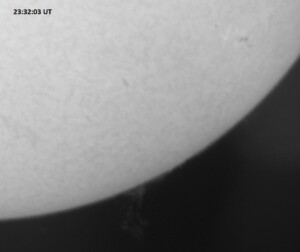 |
Solar activity is expected to be low, with a slight chance of M-class flares through 1 May.
April 28,2025
Solar activity remains at low levels. Eight spotted active regions are visible on the solar disk, including large AR 14079, just rotating into view over the eastern limb. This is the return of old AR 14055, which was tracked as it rotated across the far side of the Sun and has now been brought back to Earthly view. It produced the largest flare in several days: a C3.2 at 21:52 UT today. We were monitoring a simultaneous flare at AR 14077 which boosted the X-ray peak a bit. AR 14070 produced a C1.4/SF flare at 17:24 UT, 27 April. This region is growing some. AR 14064 produced a C2.1 flare at 18:49 UT yesterday and this one is decaying a bit as it readies to rotate out of view. AR 14069 decayed to a spotless region but that did not stop it from producing a C2.2 flare at 6:02 UT today. The remaining sunspot groups were all unremarkable.
Each of the images spans 13.8’x18.0′ on the sky. The first column contains red continuum images, each 0.25 second exposures. The second column contains H-alpha images, each 0.5 second exposures. Celestial north is up, west is right in each image.
Solar activity is expected to be low, with a slight chance of M-class flares through 30 April.
April 24,2025
Solar activity remains at low levels. Only low-level C-class flaring continues. There are thirteen spotted active regions on the solar disk, both large and small, and the ones near the disk center have been the largest and most magnetically complex. These C-flares have come from these regions. AR 14064 remains the largest spot group on the visible disk and was the source of a C2.4 flare at 14:34 UT today, followed by a C2.0 at 15:41 UT today (while the clouds continued to cover most of the sky at the Observatory). There had been some growth in this region over the last day or so. Altogether, AR’s 14064, 14067, and 14070 were the ones who produced the flares today.
Each of the images spans 13.8’x18.0′ on the sky. The first column contains red continuum images, each 0.25 second exposures. The second column contains H-alpha images, each 0.5 second exposures. Celestial north is up, west is right in each image.
Solar activity is expected to be moderate, with a chance of M-class flares from 24 to 27 April.
April 23,2025
Solar activity remains at low levels. Only low level C-class flaring activity has happened over the last two days. Most of the 9 visible spotted active regions on the solar disk are magnetically simple. AR 14069 has experienced a fairly rapid rate of magnetic flux emergence and has taken on the appearance of a flattened ring. The region has been quiet so far but does have the potential for further development. There were four low level C-class flares today so far, from AR’s 4064 and 4070.
Each of the images spans 13.8’x18.0′ on the sky. The first column contains red continuum images, each 0.25 second exposures. The second column contains H-alpha images, each 0.5 second exposures. Celestial north is up, west is right in each image.
Solar activity is expected to be moderate, with a chance of M-class flares from 23 to 25 April.
April 22,2025
Solar activity was at moderate levels early but has returned to low levels today. There was a long duration M1.3 flare from a location beyond the western solar limb at 10:48 UT today. Low level C-class activity occurred from AR’s 4062, 4063, and 4064. An unspecified source produced a C9.9 at 1:00 UT today. Since yesterday, four more spotted active regions emerged on the solar disk, all in the southern solar hemisphere. ARs 14069 and 14070 were among these and showed continued growth. AR 14062 and 14064 showed some decay in parts of these regions. Otherwise everything else is mainly quiet and stable.
Each of the images spans 13.8’x18.0′ on the sky. The first column contains red continuum images, each 0.25 second exposures. The second column contains H-alpha images, each 0.5 second exposures. Celestial north is up, west is right in each image.
Solar activity is expected to be low, with a chance of M-class flares from 22 to 24 April.
April 21,2025
Solar activity is at moderate levels today. AR 14068 rotated onto the solar disk yesterday and produced an M1.0 flare at 12:11 UT on 20 April. This was the first M-class flare since an M4.4 that occurred at 23:50 UT on 18 April. Then AR 14062 produced an impulsive M1.9 flare today at 18:37 UT (after this morning’s observation session. Only minor changes have occurred in the visible active regions over the last two days. AR 14064 produced a C3.9/SF at 0:31 UT today, and AR 14063 produced a C2.1 flare at 6:42 UT today.
Each of the images spans 13.8’x18.0′ on the sky. The first column contains red continuum images, each 0.25 second exposures. The second column contains H-alpha images, each 0.5 second exposures. Celestial north is up, west is right in each image.
Solar activity is expected to be low, with a chance of M-class flares from 21 to 23 April.
April 17,2025
Solar activity remains at low level with only minor C-class activity. AR 14062 produced most of this activity early today and yesterday, including two of the four documented C-class flares today. AR 14064 produced the largest flare for today so far (as of 23:35 UT), a C4.6 at 14:22 UT. AR 14060 also produced a C1 flare. AR 14062 is also the most complicated region on the visible solar disk today. The other six active regions were unremarkable.
Each of the images spans 13.8’x18.0′ on the sky. The first column contains red continuum images, each 0.25 second exposures. The second column contains H-alpha images, each 0.5 second exposures. Celestial north is up, west is right in each image.
There is an increasing chance for M-class flares (due to the increasing magnetic complexity of ARs 14062 and 14064) and a slight chance for X-class flares through 19 April.
April 16,2025
Solar activity drop from moderate levels to low levels. The most recent M-class flare was an M1.3 at 18:13 UT on 15 April from AR 14055 from over the western solar horizon. This region also produced a C8.1 at 4:39 UT, 16 April. Since the C8, there had only been three further low-level (c1 to c2) flares, one of which came from AR 14062. As of 23:05 UT today, no further M-class flares have occurred. AR 14060 has progressed to the western half of the solar disk, carried along by the Sun’s rotation. The region was stable but showed some minor growth for a time yesterday. There are three un-numbered regions currently on the solar disk, in addition to three numbered regions. The largest of these is AR 14060, with 180 MSH of surface area. This is the same coverage as AR 14062.
Each of the images spans 13.8’x18.0′ on the sky. The first column contains red continuum images, each 0.25 second exposures. The second column contains H-alpha images, each 0.5 second exposures. Celestial north is up, west is right in each image.
There is a chance for M-class flares and a slight chance for X-class flares from 16 to 18 April.
April 15,2025
Solar activity remains at moderate levels, with an M1.5 flare at 10:20 UT from AR 14055. An M1.3 flare occurred at 18:13 UT, also from AR 14055, which is no longer directly visible. It is situated just over the western limb of the Sun, but, in addition to the two M-class flares, was the source of two C-class flares early today. During today’s observing session, there were no observed structures in H-alpha associated with AR 14055 (there are typically surges and other elevated structures that signify the location of an active region just out of view). Another sunspot group, AR 14061 did grow a bit but quickly decayed again to only a handful of tiny spots. AR 14060 has grown just a bit but was quiet overall. AR 14062 rotated into view and has elevated the background X-ray flux level a bit but was otherwise quiet. A structure resembling a large active region just out of view (arrowed, last image below) appears to signify the imminent appearance of another large active region, which should come into view in a day or two.
Each of the images spans 13.8’x18.0′ on the sky. The first column contains red continuum images, each 0.25 second exposures. The second column contains H-alpha images, each 0.5 second exposures. Celestial north is up, west is right in each image.
Solar activity is expected to remain at moderate levels (80% chance of M-class flares on 15 April) 15 -16 April, then return to low levels by 17 April.
April 14,2025
The Sun continued at high levels of activity through early today, as the frequent M-class flares continued, but became much less frequent. The last M-class flare so far today (as of 21:30 UT) was an M4.2 at 6:50 UT. This region is severely foreshortened on the limb so it is difficult to say what it is doing for certain. Another fairly large region at solar latitude 3 degrees south has rotated into view on the opposite limb. This and all the other active regions beside AR 14055 were stable and mostly unchanged.
Each of the top row images spans 13.8’x13.8′ on the sky; the bottom row images are 18.0’x13.8′ on the sky. The first column contains red continuum images, each 0.25 second exposures. The second column contains H-alpha images, each 0.25 second exposures. Celestial north is up, west is right in each image.
Solar activity is expected to return to moderate levels, with a slight chance for isolated X-class flares through 15 April. This changes to a slight chance for M-class flares on 16 April as AR 14055 rotates further over the solar limb.
April 12,2025
Solar activity reached high levels today due to frequent low-level M-class flares from AR 14055. The largest of these today was an M2.7 at 11:43 UT today. For the entire UT day of 12 April, AR 14055 produced 8 C-class and 7 M-class flares. AR 14060 added a sub-flare and a C5.6 flare; AR 14054 produced a single C4 event. AR 14055 had grown significantly in the last two days. There was slight growth in AR 14058, and the rest of the numbered regions remained about the same.
Each of the below images spans 13.8’x18.0′ on the sky. The first column contains red continuum images, each 0.25 second exposures. The second column contains H-alpha images, each 0.5 second exposures. Celestial north is up, west is right in each image.
Solar activity is likely to remain at moderate levels, with M-class flares likely and a slight chance for X-class flares through 14 April, due to AR 14055 flare potential.
April 10,2025
The Sun continues to demonstrate low activity. AR 14055 had been the main source of solar flares for the last couple of days. So far today, it has produced three low-level C-class flares (the strongest was C3.2 at 6:28 UT). Departing AR 14045 produced a C3.7 at 16:51 UT (prior to this morning’s session) and AR 14060 produced two flares: a C2.3 at 4:50 UT today, and a C5.3 (today’s largest so far, through 23:00 UT) at 7:52 UT. AR 14055 is growing overall, the rest of the regions are small and simple.
Each of the below images spans 13.8’x18.0′ on the sky. The first column contains red continuum images, each 0.25 second exposures. The second column contains H-alpha images, each 0.5 second exposures. Celestial north is up, west is right in each image.
Solar activity is expected to remain at low levels, with a chance for M-class flares from 10 to 12 April.
April 9,2025
Solar activity briefly touched moderate levels late yesterday with an M1.5/1B flare from AR 14048, prior to our late afternoon session. This region is decaying some as it prepares to rotate out of view. AR 14054 follows it along and has displayed some slight growth. AR 14058 continues to grow. Today’s activity included only C-class flares, the largest of which was a C9.0/1N flare from AR 1405 at 17:30 UT today. It was the source of most of the flares, with 14048 being the source of two earlier C-flares.
The X-ray flux has been showing a steady upward climb, rising then leveling, rising then leveling, since 21:00 UT. It has started rising again at 22:49 UT and as of this writing, appears to be leveling off again at C3.0 levels (23:00 UT). No obvious source of this is noted on the GONG H-alpha images.
Each of the below images spans 13.8’x18.0′ on the sky. The first column contains red continuum images, each 0.25 second exposures. The second column contains H-alpha images, each 0.5 second exposures. Celestial north is up, west is right in each image.
Solar activity is expected to remain at low levels, with a chance for M-class flares from 9 to 11 April.
April 8,2025
Solar activity continues to be at low levels with none of the “likely” M-class events materializing. The quiet persists through today (up to 22:00 UT), with only occasional, low-level C-class events occurring. AR 14057 produced a C3.0 flare (the largest of today, so far) earlier today at 6:03 UT. This generated a coronal mass ejection. There are eight visible spotted groups on the solar disk, seven of which are numbered.
Each of the below images spans 13.8’x18.0′ on the sky. The first column contains red continuum images, each 0.25 second exposures. The second column contains H-alpha images, each 0.5 second exposures. Celestial north is up, west is right in each image.
M-class flares continue to be likely, with a slight chance for X-class flares through 10 April.
April 7,2025
Solar activity remains at low levels, with only low-level C-class activity observed. The last day with M-class flares was 1 April, when there were two such events: M5.5 at 6:46 UT, and M2.4 at 22:31 UT. Since then, and through the time of this writing, there had only been low-level C-lcass flares. AR’s 14048 and 14054 are the most complex active regions on the visible solar disk and they are growing and evolving over time. The trailing end of 14048 appears to be an entirely new AR emerging, but it has not yet been designated as such. AR 14048 produced all five of the C-class solar flares observed today. The largest of these was a C5.3 at 15:36 UT (just before opening). No events were noted during our observing session today. The remaining solar active regions were either stable or in slow decay.
Each of the below images spans 13.8’x18.0′ on the sky. The first column contains red continuum images, each 0.25 second exposures. The second column contains H-alpha images, each 0.5 second exposures. Celestial north is up, west is right in each image.
M-class flares continue to be likely, with a slight chance for X-class flares through 9 April.
March 31,2025
Solar activity reached high levels yesterday due to the high number of M-class flares. Between 21:00 UT on 29 March and 10:30 UT on 31 March, there were 9 M-class flares. The largest of these was an M1.6 flare at 16:42UT on 30 March. This region was the source of an X1.1 flare that occurred at 15:19 UT on 28 March (when we usually observe, but it was cloudy), the first such flare in over a month. The last X-class flare was an X2 from AR 14001 at 19:27 UT on 23 February. There have been a total of five X-class solar flares in 2025 so far. The largest solar flare of Solar Cycle 25 was an X9 on 3 January 2024.
The CME from the most recent X-flare event narrowly missed Earth. Had it impacted, it would have produced a major storm, comparable to those experienced 11 May 2024 and 11 October 2024. In the meantime, AR 14048 is growing, as is AR 14043, but the latter remained relatively quiet. AR 14044, 14046, and 14047 all showed growth. So fare AR 14048 produced the vast majority of the frequent C-class flares today, along with a single M1.2 at 10:24 UT. AR 14046 contributed a handful of events today. Apart from these two, the rest of the active regions were unremarkable.
Each of the below images spans 13.8’x18.0′ on the sky. The first column contains red continuum images, each 0.5 second exposures. The second column contain H-alpha images, each 0.5 second exposures. Celestial north is up, west is right in each image.
M-class flares are likely, with a 60% chance overall. There is a slight chance, 15%, for X-class flares through 2 April primarily due to the activity of AR 14048.
March 25,2025
Solar activity continues to be at low levels, with only C-class flares occurring. There was almost an M-class flare this morning: a C9.5 peaking at 12:29 UT from an undisclosed region (GONG imagery seems to indicate AR 14028 as the possible source). This was the largest flare since the M1 we observed on 21 March. After this, the largest flare was a C5.2 from AR 14035 at 7:37 UT on 24 March. This region has been decaying. AR 14036, however, has been growing and was the source of most of the flares yesterday and (at least early) today. The region appeared notably larger and more complex during this morning’s visual sunspot count observations, and there are indications the magnetic complexity is increasing as well. However, this region is about to rotate over the western limb so it will be out of our view in three days.
There are a total of seven spotted regions (6 numbered, one un-numbered) and six numbered spotless regions on the visible disk of the Sun. Aside from ARs 14036, 14030 (on the west limb) and a new spot grouping on the east northeast limb, the whole of the solar disk is almost completely spotless.
Each of the below images spans 13.8’x18.0′ on the sky. The first column contains red continuum images, each 0.25 second exposures. The second column contain H-alpha images, each 0.5 second exposures. Celestial north is up, west is right in each image.
There is a 30% chance for an isolated M-class flare and a 5% chance for an X-class flare (would most likely come from departing region 14036) through 27 March.
March 24,2025
Solar activity remains at low level. AR 14028 produced a C4.5 flare at 14:22 UT, yesterday, 23 March as it slowly decays. AR 14035, despite its very weak appearance, produced a C5.2 flare today at 7:37 UT. AR 14026 produced a C2.3/SF at 13:36 UT today. Otherwise these, and all the spotted active regions on the visible solar disk, remained quiet. A C1.8 flare occurred at 20:49 UT (the biggest since the C2.3 event earlier), and may have come from 14:36, but no event reports after 14:00 have been posted.
Each of the below images spans 13.8’x13.8′ on the sky. The first image is a red continuum image, 0.25 second exposure. The second is an H-alpha images, 0.5 second exposure. Celestial north is up, west is right in each image.
C-class flares are expected to continue, along with a chance for isolated M-class flares, through 26 March.
March 22,2025
After Friday’s M1.2/1N flare from AR 14028 at 15:34UT, 21 March, solar activity returned to low levels. The flare produced a fast, faint partial halo CME which is expected to impact the Earth’s magnetic field early on 23 March. AR 14033 returned as a group of tiny spots; AR 14036 is growing rapidly, gaining additional spots and magnetic complexity. New spots in the eastern half of the solar disk were small and quiet. AR 14035 is in a state of decay.
AR 14035 produced a C5.0/SF at 17:17 UT today, and AR 14036 produced a trio of subflares from 14:01 to 14:49 UT; all else was quiet all day.
Each of the below images spans 13.8’x18.0′ on the sky. The first column contains red continuum images, each 0.25 second exposures. The second column contain H-alpha images, each 0.5 second exposures. Celestial north is up, west is right in each image.
C-class flares are expected to continue, along with a chance for isolated M-class flares, through 24 March.
March 21,2025
Solar activity reached moderate levels today. AR 14028 produced an M1.2 flare at 15:58 UT today, the largest of the period and the largest since the M1.0 earlier this week. Prior to that AR 14025 produced a C4.4 flare at 17:10 UT on 20 March. We observed a significant part of each event at the Solar Observatory. AR 14031 is developing additional spots in its trailing half. Several new (and tiny) spot groups were noted on the Sun: two emerged near the central meridian north of the solar equator and are growing rapidly, and two rotated into view along the eastern limb. The remaining numbered active regions remain quiet and small.
A filament erupted near the eastern limb at 18:13 UT yesterday (after our observing session ended) but no CME was observed from this event. A fairly large prominence was seen on the eastern limb, which appeared to be lifting off (one footpoint remains on the surface, the other end is aloft). As of this writing, (21:00 UT) it appears to be thinning and disappearing. This prominence and the M1.2 flare one minute after its X-ray peak, are shown immediately below. Each is a 0.25 second exposure in H-alpha.
Each of the below images spans 13.8’x18.0′ on the sky. The first column contains red continuum images, each 0.25 second exposures. The second column contain H-alpha images, each 0.5 second exposures. Celestial north is up, west is right in each image.
C-class flares are expected to continue, along with a chance for isolated M-class flares, through 23 March.
March 20,2025
Solar activity returned to low levels after yesterday’s M1.5 flare. Today, there has only been three C-flares so far: a C5.6 from AR 14031, a C2.5 from AR 14022, and a C4.4 from AR 14025. We observed this flare from four minutes after its peak until the end of the X-ray event. ARs 14028, 14034, and 14035 have grown slightly while ARs 14020, 14022, 14025, and 14031 all appear to be decaying. Currently there are 11 numbered active regions and 2 un-numbered active regions on the visible disk today, but everything has remained mainly quiet (through 19:39 UT, 20 March).
Each of the below images spans 13.8’x18.0′ on the sky. The first column contains red continuum images, each 0.25 second exposures. The second column contain H-alpha images, each 0.5 second exposures. Celestial north is up, west is right in each image.
C-class flares are expected to occur, along with a chance for isolated M-class flares, through 22 March.
March 19,2025
Solar activity reached moderate levels with an M1.5 flare from AR 14031 at 20:40 UT today. Prior to this, only minor C-class flares happened yesterday and today, rendering the activity level low. There are 11 spotted active regions on the visible disk today (down from 13 yesterday) and several of these have grown slightly. AR 14025 is growing overall but had not produced any flares so far today. In addition to the M1.5 flare, AR’s 14028, 14030, and 14031 have each produced one C2 event so far today (through 21:05 UT). All the other regions are unremarkable.
Each of the below images spans 13.8’x18.0′ on the sky. The first column contains red continuum images, each 0.50 second exposures. The second column contain H-alpha images, each 0.5 second exposures. Celestial north is up, west is right in each image.
More C-class flares are expected to occur, along with a chance for isolated M-class flares, through 21 March.
March 18,2025
After briefly reaching moderate levels with the C9.8/M1.0 double flare from AR 14033, solar activity has returned to low levels. Frequent C-class flaring occurred before and since this event, but mostly ended with a C3.0 from AR 14028 at 4:26 UT this morning. Since then, nothing significant has occurred or been reported, through 23:00 UT (the flat X-ray plot was punctuated by a C2.1 at 21:12 UT today but no information is yet available about the source). The double-flare produced two Coronal Mass Ejections which may weakly impact the Earth’s magnetic field on 19 March. There are a total of 13 spotted active regions visible on the solar disk, but all of them are rather unremarkable. However, AR’s 14025, 14028, and 14031 each have what is called a beta-gamma magnetic type, meaning conditions are somewhat favorable for each of these to produce C- and M-class flares.
Each of the below images spans 13.8’x18.0′ on the sky. The first column contains red continuum images, each 0.50 second exposures. The second column contain H-alpha images, each 1.0 second exposures. The H-alpha images were made through a thin veil of cirrus, reducing the H-alpha contrast. The cirrus lingered for much of the morning, then cumulus clouds appeared by mid-day. The winds kicked up and atmospheric seeing was expected to deteriorate after 17:00 UT. Celestial north is up, west is right in each image.
The three active regions with the “beta-gamma” magnetic configurations mentioned above combine to provide a chance for isolated M-class flares and a slight chance for an X-class flare through 20 March.
March 17,2025
Although solar activity had been reported to be at low levels (prior to this afternoon’s M1.0 flare), this morning’s NOAA-SWPC discussion contains a lot of action. AR 14028 is growing and is one of the largest of the 13 visible spotted active regions on the Sun. It produced a C6.5/SF at 22:32 UT, 16 March, and a C7.8/1F flare at 5:42UT today. It produced a C2.7/SF at 14:30 UT today, then has been mostly quiet. ARs 14025 and 14031 continue to grow but were mostly quiet. ARs 14021 and 14034 also showed some slight growth but were otherwise quiet. Everything else was quiet and stable. A double peaked C-class event (C6.6 at 16:04 UT, and a C5.3 at 16:18 UT) was observed during today’s session. Later in the day, AR 14033 produced a C9 flare at 19:19 UT, which was immediately followed by a long-duration M1.0 event from the same active region, which peaked at 19:33 UT. These events were not observed at PVSO.
There was a disappearing solar filament yesterday which produced a CME, heading north away from the solar disk. A pair of eruptions occurred yesterday from AR 14032. These produced a pair of CMEs, which could offer a glancing blow late on 19 March but details are still pending. At around 10:32 UT today, an approximately 5 degree long filament erupted from the northwest quadrant of the solar disk. It is not yet clear whether this produced a CME. AR 14032 decayed to spotless plage yesterday.
Each of the below images spans 13.8’x18.0′ on the sky. The first column contains red continuum images, each 1.00 second exposures. The second column contain H-alpha images, each 0.5 second exposures. Celestial north is up, west is right in each image.
Solar activity is expected to be low, with a chance for M-class flares and a slight chance for X-class flares through 19 March.
March 12,2025
Solar activity is slowly increasing with more frequent C-class flares, which include two near-M-class events. No region is (yet) attributed to the C-class flares reported today, although most of these have come from AR’s 14024, 14027, and an unnumbered region that is just starting to rotate into view on the ESE limb. AR 14012 is quiet and continues to slowly decay as it starts to rotate out of view; AR 14024 is also decaying as it rotates out of view. ARs 14019 and 14020 are slowly growing, as are AR’s 14025, 14026, and 14027, each of which emerged on the disk in the last day or two.
Each of the images below is a 0.5 second exposure and spans 13.8’x18.0′ on the sky (unless otherwise indicated). Celestial north is up, west is right in each image.
There is an increasing chance for M-class flares through 14 March.
March 11,2025
Solar activity remains low with only low-level C-class flare activity occurring. There was a bit of an uptick in activity today as newly emerged AR 14024 (due north of 14012) began to flare. It produced an M1.1 at 13:04 UT today, then a C5.8 at 18:30 UT. There was a C7.2 event at 19:16 UT today and a C9.6 at 21:22 UT today but no information is yet available as to the source(s) of these events. AR 14012 continues to decay as it approaches the western limb and it remained quiet yesterday and all day today. AR 14019 is growing and may have increased potential for M-class flare activity in the coming days. There are a total of 8 spotted regions visible on the Sun today: two small ones are about to rotate out of view, and the remaining occupy the northeast quarter of the solar disk.
Each of the top row of images spans 13.8’x13.8′ on the sky; each of the bottom row images cover 13.8’x18.0′. The first column contains red continuum images, each 0.25 second exposures. The second column contain H-alpha images, each 0.5 second exposures. Celestial north is up, west is right in each image.
There is a chance for M-class flares through 13 March as AR 14019 grows in size and complexity.
March 10,2025
Solar activity continues to be at low levels. Only minimal C-class activity occurred yesterday and today. A lone M1.6 flare occurred on 7 March at 21:00 UT, but everything has been quiet since. The largest event since yesterday’s C2.5 at 18:54 (from an unnumbered region that is just rotating into view) was a long-duration C2.0 flare that appears to have come from AR 14020 (based on GONG imagery). This event peaked at 20:32 UT today. AR 14012 continues to decay and produced a few minor C-class flares yesterday, nothing today. AR 14019 is beginning to grow but was quiet all day today. It did produce a C1.7 flare yesterday at17:21UT. AR 14018 is also showing signs of growth, but has been quiet. All the other numbered regions were unremarkable.
Each of the images below span 13.8’x13.8′ on the sky. The first column contains red continuum images, each 0.25 second exposures. The second column contain H-alpha images, each 0.5 second exposures. Celestial north is up, west is right in each image.
There is a chance for M-class flares through 12 March as AR 14019 grows in size and complexity.
March 6,2025
Solar activity remained low today with only occasional low-level C-class flaring. AR’s 14007 and 14012 have decayed some, AR 14016 has grown earlier but is now mostly stable, and the rest of the spotted active regions are either stable or in decay.
Each of the top row of images spans 13.8’x13.8′ on the sky; each of the bottom row images cover 13.8’x18.0′. The first column contains red continuum images, each 0.25 second exposures. The second column contain H-alpha images, each 0.5 second exposures. Celestial north is up, west is right in each image.
There is a chance for M-class flares and a slight chance for X-class flares from 6 to 8 March due to ARs 14012 and 14016.
March 5,2025
Solar activity bumped up to moderate levels with an impulsive M1.7 flare at 11:50 UT today (5 March). This was the first M-class flare from any region in over one week. Since the event, the Sun returned to low activity levels with only a C1 flare from AR 14007 at 17:38 UT. AR 14016 produced a C1 flare at 0:44 UT today, and AR’s 14009 and 14012 each produced a C1, at 2:54 UT and 8:26 UT, respectively. ARs 14012 and 14016 continue to grow. The remaining spotted active regions appear to be in decay.
Each of the below images spans 13.8’x13.8′ on the sky. The first column contains red continuum images, each 0.25 second exposures. The second column contain H-alpha images, each 0.5 second exposures. Celestial north is up, west is right in each image.
There is a 40% chance for M-class flares and a 5% chance for X-class flares from 5 to 7 March as AR 14012 has grown.
March 4,2025
Solar activity continues to be low and has been so since last week. The largest flare (yesterday or today) was a C4.6 event at 15:45 UT from AR 14012. This region, along with AR 14006, has been responsible for all of the flares, all low-level C-class. AR 14006 is in decay as it rotates out of view, but AR 14012 is growing in size and spot number. AR 14007 also showed some growth but remained quiet.
Each of the below images spans 13.8’x13.8′ on the sky. The first column contains red continuum images, each 0.25 second exposures. The second column contain H-alpha images, each 0.5 second exposures. Celestial north is up, west is right in each image.
Solar activity is expected to remain low, with a chance for M-class events through 6 March. If AR 14007 and/or 14012 continue to grow in size and complexity, the M-class events could become more likely, and a slight chance of X-class events could be possible.
February 28,2025
With clear skies once again, follow up observations of a quiet Sun were made in the late morning hours. Solar activity continues to be at low levels with only C-class activity (C5 and less since 0:00 UT, 28 February through at least 23:11 UT) occurring fairly regularly. AR’s 14009 and 14010 emerged onto the solar disk (see labeled image below), and they weren’t visible (through the thin clouds) yesterday. All of the regions were stable or in decay. AR’s 13998, 14006, and 14007 were the sources of the flares.
Each of the below images is a 0.5 second exposure and covers 13.8’x18.0′ of sky. The first two are identical red continuum images, the second of which is labeled. The third (right most) image is H-alpha line center. Celestial north is up, west is right in each image.
M-class events continue to be forecasted to be likely today (28 Feb.) and tomorrow (29 Feb.), with a chance of X-class flares during this period. There is a chance for M-class flares on 2 March, with X-class flaring unlikely by then.
February 27,2025
Weather was cloudy today but the clouds thinned enough to allow the Sun to shine through fairly strongly. This was enough for a complete set of continuum images, although they were made through cirrostratus clouds of varying thickness. H-alpha imaging was attempted, unsuccessfully, due to even the presence of thin clouds greatly reducing the contrast.
Solar activity remained at low levels. AR 14007 produced a C5.7 flare at 12:42 UT on 26 February. AR 13998 produced a C5.7 event at 6:34 UT on 27 February. This region decayed some as it exited the solar disk, being carried away by the Sun’s rotation. Shortly after this flare, AR 13998 produced a C7.5 event at 12:36 UT, then was quiet for the rest of the day. AR 13996, also rotating out of view, produced a near-M-class event: a C9.3 flare at 23:24 UT, the largest in over two days.
A filament erupted in the southwest part of the solar disk on 26 February and produced a CME that became visible to SOHO by 14:48 UT. This CME is expected to miss the Earth, passing by ahead of the Earth in it’s orbit.
Each of the below red continuum images is a 0.5 second exposure and covers 13.8’x18.0′ of sky. Celestial north is up, west is right in each image.
M-class flare events continue to be likely, with a chance for X-class events, from 27 February t0 1 March.
February 26,2025
Solar activity returned to low levels. The last M-class flare (to date, as of 20:45 UT) was the long-duration M3.6/1F flare at 11:59 UT yesterday from AR 13998. Since then, only occasional low-level C-class flares have occurred. AR 14007 produced a pair of C-class flares: a C3.6 at 3:45 UT today, and a C5.7 at 12:42 UT today. After these, AR 13998 produced a pair of C-class flares: a C2.9 at 14:29 UT today and a C4.4 at 18:50 UT today. The remaining regions were quiet today and most of yesterday.
Each of the below images spans 13.8’x13.8′ on the sky. The first column contains red continuum images, each 0.25 second exposures. The second column contain H-alpha images, each 0.5 second exposures. Celestial north is up, west is right in each image.
M-class flares are likely with a chance for X-class flares from 26 to 28 February.
February 25,2025
Solar activity remains at moderate levels. ARs 14000 and 14001 produced M-class flares yesterday, and AR 13998 only produced C-class flares yesterday. Today, it was the source of an M1.3 flare at 2:47 UT and an M3.6/1F flare at 11:59 UT. The Sun has been mainly quiet since, punctuated by a C4.2 from 13998 at 17:58 UT; and a C4.1 at 18:10 UT from AR 14000 (just as the clouds began to break up at the PV observatory. Except for the two C-class events, the X-ray curve has been quite flat (gently sloping down) since 112:45 UT, through at least 21:10 UT.
The long duration M3.9 flare from yesterday actually came from a region off the southwest limb at solar latitude S14. The flare peaked at 23:02 UT, and a CME emerged from this location a few hours later. The cloud of charged particles is expected to pass ahead of Earth in its orbit, missing it totally.
Each of the below images spans 13.8’x13.8′ on the sky. The first column contains red continuum images, each 0.25 second exposures. The second column contain H-alpha images, each 0.5 second exposures. Celestial north is up, west is right in each image.
M-class flares are likely with a chance for X-class flares from 25 to 27 February.
February 24,2025
Since 20 February, solar activity increased to high levels. From 21 February to this writing (23:15 UT, 24 February), nine M-class flares and one X-class flare occurred. The X class flare was an X2.0 from just over the Sun’s western limb from departing AR 14001. It also produced an M1.3 flare today (24 February) at 1:46 UT. This region since became quiet as it rotated out of view, but may be responsible for the current longer-duration M-class flare (peaking at M3.9 at 23:06 and has slowly started to decrease). The GONG H-alpha images have not shown any signs of flare activity during this event. AR 14000 produced an M1.3 flare at 7:02 UT, and an M1.5 at 21:01 UT today. AR 13398 was the source of four C-class events, the largest of which was a C8.7 at 13:20 UT today.
Each of the below images spans 18.0’x13.8′ on the sky. The first column contains red continuum images, each 0.25 second exposures. The second column contain H-alpha images, each 0.5 second exposures. Celestial north is up, west is right in each image.
M-class flares are likely with a chance for X-class flares from 24 to 26 February.
February 20,2025
Solar activity continues to be at low levels, with no M-class flares since the M1.0 event at 15:15 UT on 17 February. Since then, only C-class activity was observed. The largest event since then (up to the time of this writing, 21:20 UT) was a C8.1 at 23:45 UT on 19 February, which came from near plage associated with spotless region 13991. This produced a Coronal Mass Ejection off the SW part of the solar disk. AR 13996 is the largest and most complex active region on the visible disk, but only produced some C-class flares. AR 13998 is showing some magnetic flux emergence but has been quiet, producing only a C1.3 flare at 14:08 UT on 19 February. AR 13996 had been responsible for most of the flares observed today. It produced 4 low-level C-class flares (3- c1 and 1 C4) between 0:00 and 23:15 UT today.
Each of the below images spans 18.0’x13.8′ on the sky. The first column contains red continuum images, each 0.25 second exposures. The second column contain H-alpha images, each 0.5 second exposures. Celestial north is up, west is right in each image.
Solar activity is expected to be low with a chance for isolated M-class flares and a slight chance for X-class flares through 22 February.
February 17,2025
Solar activity remains at low levels, except for an M1.0 flare from AR 13992 at 15:13 UT which briefly bumped it up to moderate. AR 13990 is in decay with most of its western spots dissipating. AR 13992, as it departs over the western limb, produced a C5.9 flare at 4:46 UT today and grew a bit in the process. AR 13996 has shown some magnetic shear activity but was quiet overall. AR 13998 has shown rapid emergence of magnetic flux and produced a C6.1 flare at 18:38 UT on 16 February. AR 13999 is also growing rapidly but stayed mainly quiet. Prior to today’s M1.o flare, the last M flare was around 21:00 UT on 14 February, with three preceding this on the 14th and 13th of February.
Each of the below images spans 18.0’x13.8′ on the sky. The first column contains red continuum images, each 0.25 second exposures. The second column contain H-alpha images, each 0.5 second exposures. Celestial north is up, west is right in each image.
Solar activity is expected to remain low with a chance for M-class flares and a slight chance for X-class flares through 19 February.
February 13,2025
Solar activity has returned to low levels and has been mostly at low levels since the AR complex rotated over the solar limb a few days ago. Only occasional M-class flares have occurred since 8 February, about one every day or two. The most recent was an M1.0 from newly-emerged AR 13992 (just east of AR 13987). This event occurred at 11:09 UTC today. Since then, only minor C-class flares have happened from this rapidly growing active region as well as AR 13990. Another medium-sized spot is rotating into view over the Sun’s east northeast limb, bringing the total of spotted active regions to 9 (this includes a pair of spots that just emerged at S19 E 11). A long duration C9.0 flare peaked at 22:43 UT today and, based on GONG imagery, appears to have come from the eruption of part of a filament.
Each of the below images spans 18.0’x13.8′ on the sky. The first column contains red continuum images, each 0.25 second exposures. The second column contain H-alpha images, each 0.5 second exposures. Celestial north is up, west is right in each image.
Solar activity is expected to remain low with a chance for M-class flares through 15 February.
February 8,2025
Solar activity returned to moderate levels briefly early today when AR 13981 produced an M2.0 flare today at 9:27 UTC. This was the largest event since the M7.6 nearly exactly 24 hours earlier. Since then, and for the rest of the day, no further M-class flares occurred. AR 13981 also produced five documented C-class flares today, through 21:30 UT. AR 13894 has started to produce flares, with six documented during this period. The largest of these was a C8.0 at 12:54 UT. AR 13981 has shown signs of decay, while AR 13978 has grown some. The dark filament south of the AR complex appeared to be active during the observation period but has not shown any indication of launching or disappearing through 22:00 UT.
The active region complex is approaching the western limb of the Sun. Solar activity remained at low levels since the M2 flare. A new large spot is starting to rotate into view on the ENE limb. This, and most of the visible active regions were quiet and stable.
Each image covers 13.8’x18.0′ on the sky, with celestial north up, west right. The first column and the top image of the second column are red continuum images, each 0.25 second exposure. The remaining images are each H-alpha, each 0.5 second exposures.
Solar activity is expected to be at moderate levels, with a chance for isolated X-class flares from now through 10 February. This is due to the active region complex nearing the NW limb of the Sun.
February 7,2025
Solar activity was high today because of an M7.5 that happened overnight (in Southeast Texas), 9:21 UT today from AR 13981. This region produced an additional pair of M-flares prior to this larger M-class event: an M1.6 at 6:30 UT today, followed by an M3.2 51 minutes later, at 7:21 UT. AR 13978 also produced an M2.3/1N event yesterday, 6 February at 23:27 UT.
There was a near-M flare at 12:14 UT today from the same region, AR 13981, a C9.1 event. Since then, through the time of this writing, there had only been occasional low-level C-class events, mainly from 13981. This region experienced some decay in the trailing end, and some new spot emergence in the leading end. All of the other spotted regions were either stable or in decay. There are currently a total of 9 spotted active regions on the visible disk.
The weather was clear enough this morning only for a brief interval, allowing only red continuum images to be obtained. Contrary to the forecast from most sources for today, sunny skies did not return (overcast conditions did, just after these images were taken) and skies remained cloudy the rest of the day. Each of the below is a 0.25 second exposure and covers 13.8’x13.8′ on the sky, with celestial north up, west right.
Solar activity is expected to return to moderate levels (after being at low levels after 12h UT today), with a chance for isolated X-class flares from now through 9 February. This is due to the active region complex nearing the NW limb of the Sun.
February 6,2025
Solar activity was high today due to an M7.6 flare from AR 13981 at 11:04 UT today. This event produced ejected material visible in extreme ultraviolet satellite images and a coronal maxx ejection later in the day. AR’s 13981 and 13977 produced the majority of the flaring over the last two days. There were some contributions of C-class activity from ARs 13976 and 13984.
Since the M7 flare, there had only been low-level C-class events. And then AR 13976 produced a C9.3 event at 22:35 UT. This was followed by an M2.3, peaking at 23:27 UT.
Each of the below images spans 18.0’x13.8′ on the sky. Except for the filament image immediately below, the first column images are red continuum images, with 0.25 second exposures. The second column (including the filament image) are H-alpha images of 0.5 second exposure each. Celestial north is up, west is right in each image.
Solar activity is expected to remain at least at moderate levels with a chance for isolated X-class flares through 8 February, due to the complex of active regions in the northwest solar quadrant.
February 4,2025
Solar activity for today remained at moderate levels as the frequency of M-class flares has decreased considerably. Since (and including) the M4 event at 18:36 UT yesterday, there had been 8 M-class flares, the largest of which was an M4.8 from AR 13981 at 11:21 UT today. The most recent event was an M1.1 at 13:45 UT today. Since then, through this writing at 0:00 UT (5 February), there has been no further M-class activity, only low-level C-class flares. AR 13981 continues to be the source of the vast majority of flare and is continuing to grow in size and magnetic complexity. AR 13978, as of today, has become AR 13978 (south part) and 13984(north part).
Outside of this cluster of active regions, there are only tiny sunspot regions that are either stable or in decay, and are magnetically simple. AR 13983 is a newly visible region on the eastern limb.
(Seeing was rather poor today, hence the slightly blurred images.) Each image covers 13.8’x18.0′ on the sky. The first is a red continuum image of 0.25 second exposure, the rest are H-alpha line center images, each 0.5 second exposure. Celestial north is up, west is right in each image.
Solar activity is expected to remain at moderate levels, with a slight chance for isolated X-class flares through 6 February, due to the complex cluster of active regions in the northern solar hemisphere.
February 3,2025
Solar activity was high due to a high number of M-class flares, 14 total from 10:14 UT on 2 February to 23:30 UT on 3 February. The largest of these was an M8.8, which came from AR 13981 at 3:58 UT on 3 February. It also produced an M6.1 at 13:18 UT on 3 February. This region was responsible for nearly all of these flares. It is the trailing region (and largest region) of the 5 region active region complex currently marching across the solar disk, carried along by its rotation. Taking all 5 groups together, this complex covers 860 millionths of a solar hemisphere (MSH).
Each image covers 13.8’x18.0′ on the sky. The first is a red continuum image of 0.25 second exposure, the rest are H-alpha line center images, each 0.5 second exposure. Celestial north is up, west is right in each image.
Solar activity is expected to remain at moderate levels, with a slight chance for isolated X-class flares through 5 February, due to the complex cluster of active regions in the northern solar hemisphere.
January 31,2025
Solar observations resume with the Sun returning to active levels. There was an M1.0 from AR 13976 at 6:10 UT on 31 January. This region is part of a triangular-shaped three group complex which is rotating into view from the ENE limb. Then, less than 8 hours later, at 14:06 UT, the region produced an M6.7/1N event, which is also imaged below by Solar Dynamics Observatory. The extreme ultraviolet image is an animated gif that will show several images highlighting the flare’s activity. All three regions of this complex (AR 13976, 13977, and 13978) have shown minor growth recently, and this flare event was the largest in at least one week (likely longer).
A solar filament, about 18 degrees in length on the Sun, centered near Solar Coordinates S35 E30 disappeared between 13:00 and 15:00 UT on 30 January. This produced a coronal mass ejection off the SE limb, which is expected to deal a glancing blow to Earth’s magnetic field on 2 February.
The power cord for the H-alpha filter was unavailable so only continuum images were taken during one short session today. The below is two copies of the same field of view, which includes all but one of the active regions currently visible on the solar disk. The image was taken at the time indicated and is shown in both labeled and un-labeled format. The image, a 0.25 second exposure, covers 13.8’x18.0′ on the Sun.
 |
 |
Solar activity is likely to reach moderate levels between now and the end of the day, 2 February, primarily due to the flare potentials from the active region complex in the northeast quadrant of the Sun.




